The Regia Marina in 1939 had far more submarines than Germany, 116 (107 for other sources) versus 72 (and still more than the IJN, about 70 in 1941), so topping the Axis. This fact must be recalled before going further. Like other navies, the Regia Marina divided these in two classes, oceanic (long-range cruisers) and coastal units. However during wartime, the accent was placed on four designs:
-Mass-built Coastal types, with a kiosk design influenced by U-Boats’s
-Large transport types (to supply Japan)
-Midget subs of the ‘C’ types
-Spec Ops conversions (like the Circe operating the Maiales)
However, Italy could never approach the industrial scale of Germany and basically construction was limited to the coastal types of the Acciaio and Flutto types (24 completed in all) and about 30 midget subs, the four oceanic Cagni, and the “japan cargo” transport types of the Romolo class (only two completed).
Italian submarine design
WW1 Italian submarine design
Going back from well before the great war, Italy innovated with the famous double hull concept pioneered by Laurenti, which was breveted, copied and widely used. But the Regia Marina’s first submersible was the Delfino in 1890, built at La Spezia by marine engineer Giacinto Pullino. Although laid down in 1889, she was completed in 1892 but spent until 1895 in sea trials before being accepted. At that time she was an already impressive 95 tons cigar powered by an anemic 65 hp Savigliano electric motor, good for 6 knots in surface…
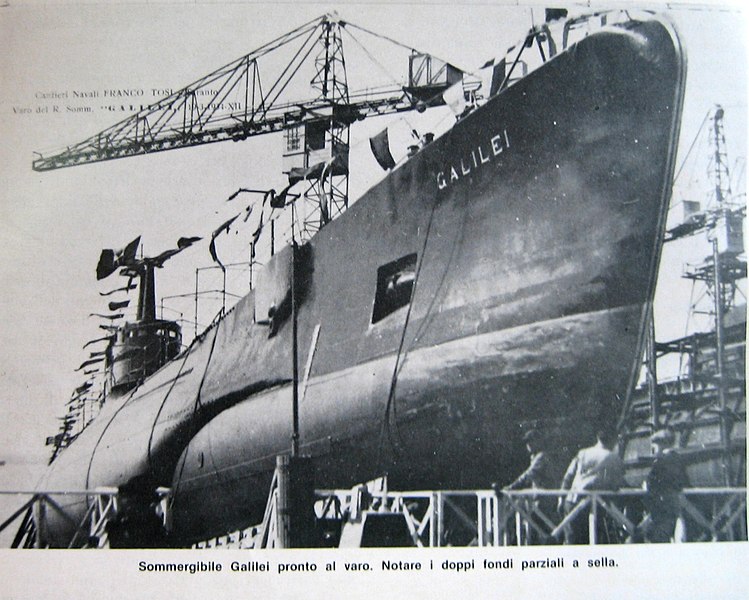
The launch of Galileio Galilei, of the excellent Archimede-class at Tosi yard in 1934.
She was rebuilt later, with power doubled. The first serial class, Glauco (1905), was followed by the single Foca (1908), Medusa class (1911), while the Navy ordered a German submarine, Atropo, in 1912 followed by the Nautilus and Pullino classes and the single Argonauta in 1913, alternatively built by La Spezia and Venice NyD. Wartime production was even greater, with the F type made with the hull designed by Lt. Cdr Cesare Laurenti at San Giorgio Yards, the N class (1917), and the large medium boats of the Pacinotti and Provana classes or the cruisers of the Micca class (1918). In the addition of the minelayers of the X types, Midgets of the Alfa, A, B types were also built. A future dedicated post will showcase all these types in detail.
Interwar Italian submarine design
While the F, and N classes were only discarded gradually from 1928 to 1935, the 1916 N class were still active throughout and also served during the second conflict, as well as the X types minelayers as they were quite precious. However Italy started to design new submarines from 1925 after the observation or foreign models (like the British W class transferred during the great war) and the coveted late WW1 German U-Boats. 1927 saw at the same time the completion of two series of boats, medium oceanic types of the Ballila class and the coastal Mameli class.
The first displaced two times more at 1874 tons submerged versus 993.
They used large FIAT diesels while the first were propelled by smaller Tosi models, half the power, both electric and fossil, a smaller gun at 105 versus 120 mm and the same numbers of torpedo tubes (four forwards, two stern) but less torpedoes, 10 versus 16. They had in common the Laurenti-designed double hull with intermediary compartments and bulkheads, bathtub type kiosks with the AA installed on its rear.
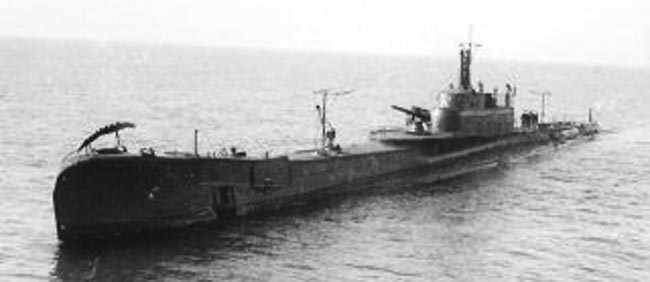
The oceanic submarine Ettore Fieramosca. This Bernardi design from 1929 was once fitted with a hangar for a small foldable floatplane, which was never installed. She was able to cruiser at 15 knots with 150 tons of oil for the diesels, giving her a transatlantic reach.
The two lines evolved in parallel during the interwar, with some variants. For example, the Archimede, Glauco, Micca, Calvi and Marcello classes had two deck guns, while the Foca introduce a rear main gun protected by the kiosk “bathtub” like British designs, followed by the Brin and Liuzzi. The wartime Marconi came back to a single deck design, and the Calvi to two decks guns on a raised platform either side, fore and aft of the kiosk.
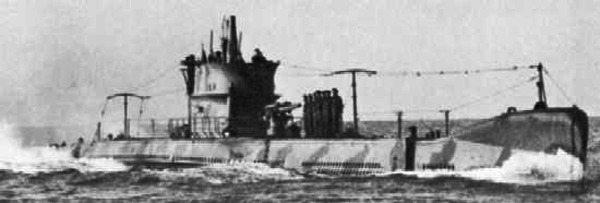
A modernized, camouflaged squalo boat showing its 102mm/35 Schneider-Creusot model 1914 gun
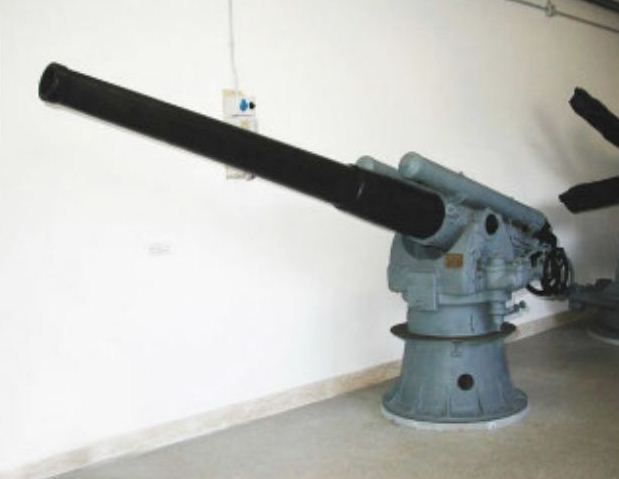
Preserved deck gun of the model 1914 102 mm/35 at La Spezia.
A that stage, German influence was prevalent, and the interwar style “bathtub” kiosk was history. Probably the largest and most interesting interwar model was the 2000 tons Fieramosca, an Italian attempt as a true “cruiser submersible”, with an hydroplane hangar mounted in the conning tower. It was designed by Bernardis. The second largest was the minelayer Pietro Micca, an Italian equivalent to the British Porpoise.

The Perla, an Acciaio type wartime submersible, camouflaged with probably dark green spots on light grey. The German style conning tower is quite evident there.
The coastal units were rather more conservative in their approach, with the same invariable 1000 tons submerged tonnage, armament (single 100mm deck gun forward), six submerged tubes, although some classes tried variations like the minelayers Bragadin class (4 tubes), or the hunter-killers of the Squalo and Settembrini classes (four tubes forward, four aft).
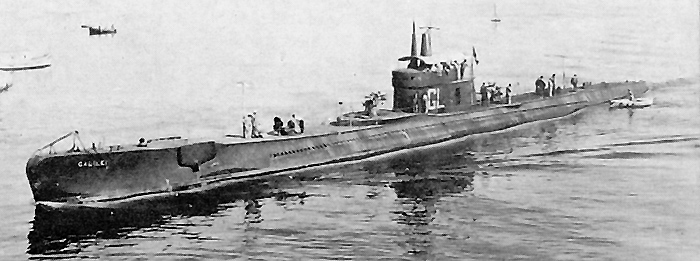
Galileo Galilei, Fraccaroli coll.
However by 1930, Bernardis was asked for quantity more than quality, and designed a 600 ton coastal type which knew few modifications up until 1943. The Argonauta, Sirena, Perla, Adua, Acciaio and wartime Flutto were not only remarkably similar and largely produced (whereas previous designs were often pairs), but they were arguably the most cost-effective submersibles of the Regia Marina, also traduced by many export successes.
Regia Marina’s submarines in operation
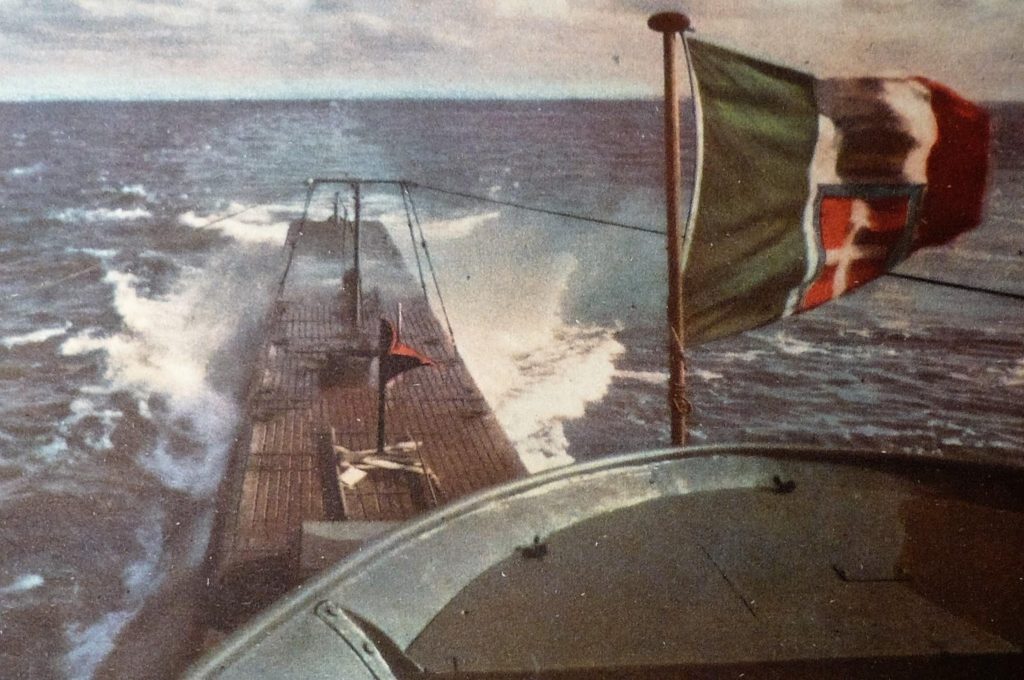
Let start by an odd note about relations between the Regia Marina and the allies when the war broke out: On 21 September 1939, Italy agreed with Great Britain that her submarines would remain on the surface, and under escort, when leaving their exercise areas. Britain was also to be notified in advance and therefore submerged submarines caught were already presumed to be hostile.
Mussolini declared war to France on 10 June 1940, and at first focused on army and air operations towards the border and an attempt to take the French Riviera.
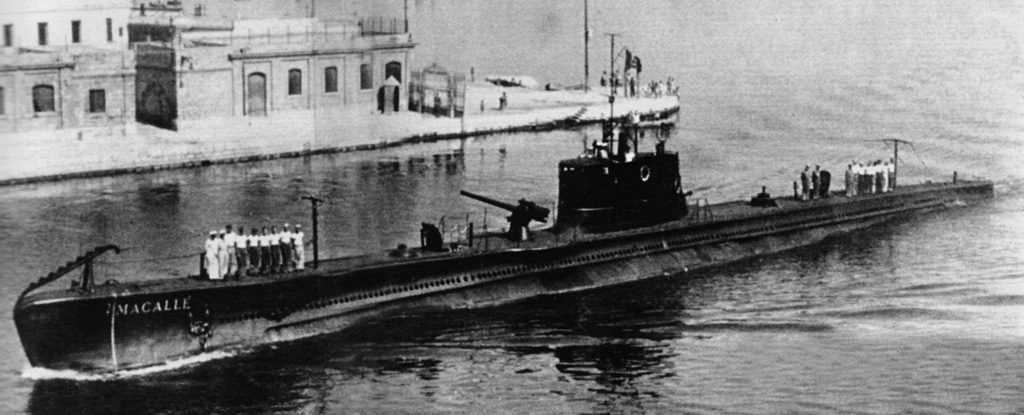
Macalle at Taranto
Meanwhile, the Regia Marina prepared to secure lines of communications between Italy, North and Eastern African colonies. This was not good news for Italian trade though, as a third of the Italian merchant shipping fleet was caught without warning in neutral ports outside the Mediterranean, 212 of 786 ships over 500 GRT from 10 June 1940 (1,216,637 GRT of a total 3,318,129).
After France surrendered Supermarina efforts veered towards the British “locks” and strategic positions in the Mediterranean: Malta in particular, targeted in priority since the island was right under Sicily, the hinge of the Mediterranean. But this proved a grinding match. The Suez canal was mostly threatened at one point by the Afrika Korps (and the harbor was subjected to Italian commando assaults), Sicily was mostly dominated by the Luftwaffe and Gibraltar was left in the reluctant hands of Franco. As minister and Admiral Paolo Thaon di Revel stated in parliament on 30 March 1925, Italy was “prisoner in the Mediterranean”.
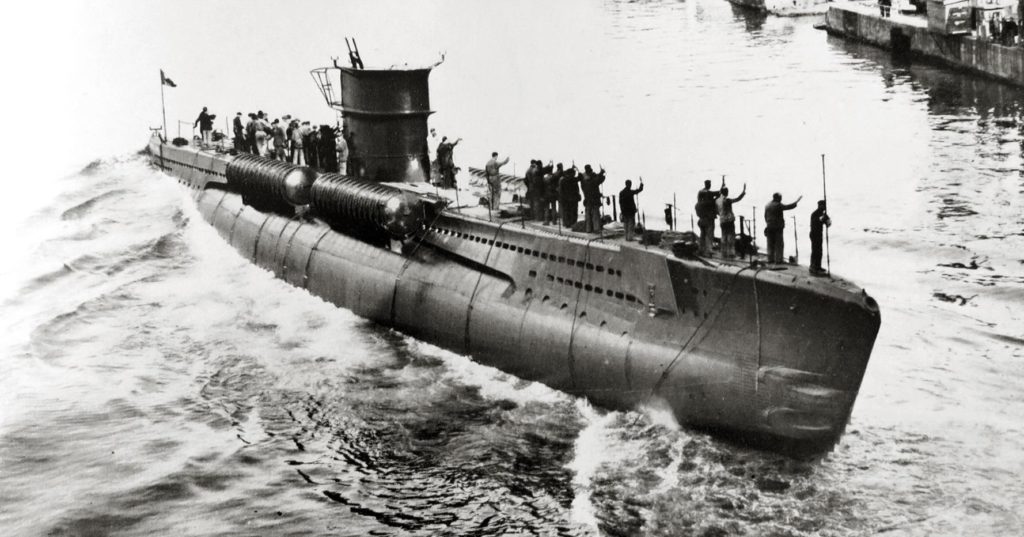
Launch of Murena, 1943
Italian submarines gained a hunting board, but no more impressive by the one gained by Italian small attack craft or by British submariners in the area, triggering a reaction by building brand new torpedo boats and ASW corvettes. One of the major contributions however to the axis effort was a relatively successful Atlantic campaign by Italian submarine force from Bordeaux.
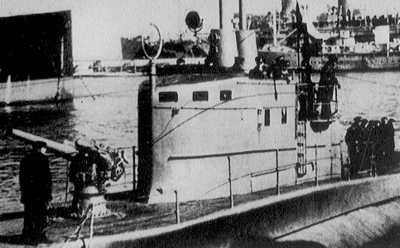
UIT-23 alias Reginaldo Giuliani arrives at Gotenhafen in April 1941 for operation Marigammasom.
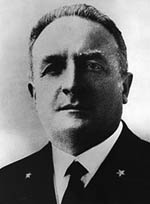
Admiral Mario Farangola (1880-1967): Graduated of the naval academy in 1902, he participated in the Italo-Turkish war onboard armored cruiser Giuseppe Garibaldi and during ww1 served on the submarine Argo, and later F 7 as captain, and later the Lorenzo Marcello, winning five medals and promotion, allowing him to command during the interwar the destroyers Tigre and Leone, and from 1932 the battleship Giulio Cesare. The same year he became Rear Admiral, appointed Naval Commander of Sicily, commander of the La Spezia Naval Base and from 1935 vice admiral, inspector of new constructions and commander of the submarine fleet.
He also supervised successful testings of the SLC manned torpedoes, in La Spezia. Until December 1941 he was commander of the Submarine Squadron in the Mediterranean. He was an ardent supporters of submariners, writing a long report highlighting all the deficiencies of the Italian submarine branch, and was removed from office afterwards, relegated to the Corps of Port Captaincies for the remainder of the war. Like Legnani he was an ardent Fascist and joined the Italian Social Republic, staying at the general command the Port Captaincies until the end of the war. His sons served also with the RSI on the Decima Flottiglia MAS, later captured and executed by the Italian resistance.
Italian submersibles in the Mediterranean
On 13 June Operation Vado saw limited naval clashes between the Italian and French navy. Admiral Domenico Cavagnari, Naval chief of staff planned to use his surface fleet to mine the Sicilian Channel and launch his submarines against Allied shipping. On 12 June, Dandolo fired (but missed) light cruiser Jean de Vienne and south of Crete, Bagnolini sank the British cruiser HMS Calypso. On 17 June, Provana attacked a French convoy off Oran but was depth charged and rammed when surfaced by the sloop La Curieuse, the only submarine loss to the French.
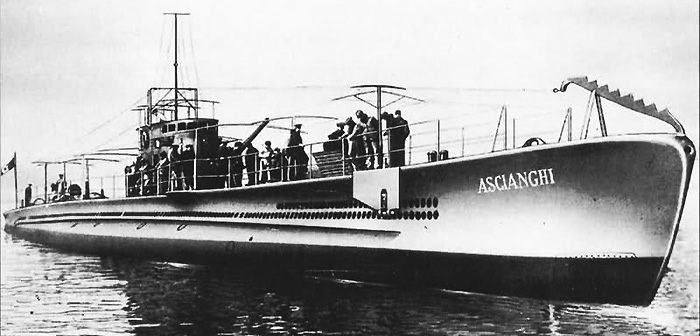
Submersible ASCIANGHI
When the war broke out on 10 June 1940, the Royal Navy had 62 combat surface ships and 12 submarines in the Mediterranean, spread between Gibraltar, Malta and Alexandria, with an emphasis on the first. The French Navy had 78 surface ship and 40 submarines in the area, which was by agreement with the British, her main defense priority. After elimination (notably after the controversial operation Catapult), the Italian Royal Navy could oppose to the Royal Navy 83 surface ships, 138 torpedo boats, and 113 submarines.
So when the second phase began against British shipping and interests in the Mediterranean, the Regia Marina enjoyed a considerable advantage on paper. At least on paper, because her own deficiencies were not obvious then: The lack of aircraft carrier, poor coordination with the Regia Aeronautica, no radar, limited ASW and AA capabilities. 10 were lost in the first twenty days of action, and later on, 25 to 30 Italian boats were at sea at any one time.
Tactically, Italian submarines did not operate in “wolf pack” tactics and operations were conducted independently, both in the Atlantic and South Atlantic. And the Regia Marina staff gave strict patrol orders, on planned routes not leaving much initiative to the captains.
Nevertheless, Italian submarine were technologically equal to their task and performed accordingly, but lacked an adequate snorkel for diesel operations underwater. They were not very successful overall because simply the lack of targets, but suffered from deficiencies: Slow diving times and poor handling underwater. Their large conning tower made them easier to spot on the surface, and slower to dive, and were more conspicuous compared to the nimble German Type VIIC. Conversely, The allied had also a hard time in the confines of the Mediterranean with long-range submarines. The British ultimately retired their T class submarines, withdrew in favour of the smaller S and U class boats.
Arguably Italian coastal submarines proved better adapted here. There was no deficiency from the crews either, which had good morale, were brave and were reasonably trained. Deficiencies were ironed up, as shown by the good wartime classes of the “metal” boat, the Acciaio and Flutto.
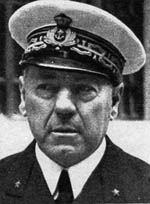 Admiral Antonio Legnani (1888-1943): Born in Piedmont, Legnani graduated from the naval academy and participated in the Italo-Turkish War as a sub-lieutenant on the Staffetta in the red sea. During WW1 he served on battleships, cruisers and auxiliary cruisers, also taking part in the operations in Albania. He also took command of the submersible Argonauta from 30 September 1917, leading 30 combat missions and winning two bronze medals and two silver medals for valor.
Admiral Antonio Legnani (1888-1943): Born in Piedmont, Legnani graduated from the naval academy and participated in the Italo-Turkish War as a sub-lieutenant on the Staffetta in the red sea. During WW1 he served on battleships, cruisers and auxiliary cruisers, also taking part in the operations in Albania. He also took command of the submersible Argonauta from 30 September 1917, leading 30 combat missions and winning two bronze medals and two silver medals for valor.
During the interwar he commanded the scout cruiser Venezia, later the submersibles Manara, while also being promoted as chief of staff of the Northern Tyrrhenian Naval Department. From 1933 he commanded the light cruiser Alberico da Barbiano and heavy cruiser Pola from 1936. After some duty in the Staff in the Ministry of the Navy, he became rear admiral and became commander in chief of the Regia Marina’s submarine fleet. His most controversial (and incomprehensible decision) was to scrap the entire Italian snorkel program called the “ML” apparatus, which could have given quite an edge on Italian submersibles during WW2, despite positive tests. During the war he commanded the cruisers 8th Naval Division, in the battles of Calabria, Taranto and Cape Matapan. When Italy capitulated he chose to collaborate with the Germans and was soon Secretary of State to the Navy of the Italian Social Republic, only to die in a car accident.
About Italian Magnetic Torpedoes:
Italy had an advanced Torpedo design, by Professor Carlo Calosi which invented the magnetically activated torpedo. It exploded when passed under a ship’s keel, like having a proximity fuse. This resulted in esxcellent attack/kill ratio. However the allies soon found a coountermeasure: At the time of the Italian Armistice, the same Prof. Calosi was ordered by the Italian Navy Experimental Weapons Division, to find a disrupting system for the magnetic field of a torpedo. At that time, U-Boats were using them in droves, and the countermeasure was fitted on allied Merchant Ships, rendering these torpedoes harmless and helping greatly the war effort.
In December 1941, Admiral Antonio Legnani replaced Admiral Mario Falangola at the head of submarines.
From 1942 and until the country surrendered, the situation improved and from November 1942 (Operation Torch), there was no lacking of suitable targets anymore.
However, ASW warfare became vicious, and heavily guarded convoys proved a tough nut to crack. Results were modest with 21 merchantmen and 13 enemy warships sunk (about 100,000 tons). Outdated doctrine with static patrols and firing only one or two torpedoes, plus technical deficiencies were gradually improved and by 1942 during Operation Pedestal, Italian submariners proved aggressive and capable, inflicting heavy losses to the British relieving fleet.
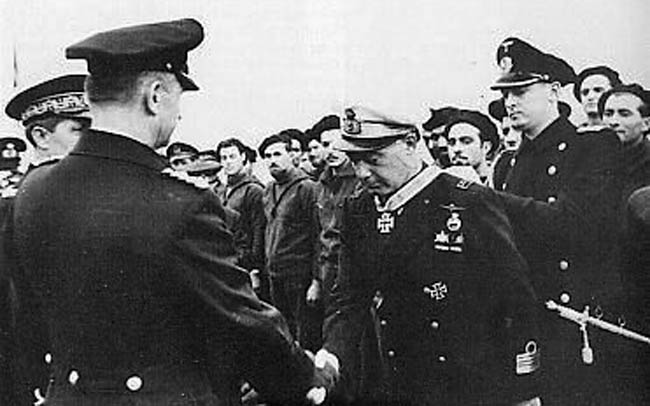
Karl Dönitz decorating Captain Enzo Grossi – Credits: http://madmonarchist.blogspot.com
In September 1943 when Italy surrendered only 34 submarines were left, 92 vessels has been lost in action (2/3), together with 3,021 men lost at sea, showing Italian commitment in the effort.
But it should be underlined that, despite the poor reputation made by modern medias to the Italian army at large during WW2, the fleet and especially submarine fleet performed admirably given the limited resources of Italy. Not only the Italians in 1940 had the largest submarine fleet in the world by tonnage, but their very active participation in the “Battle of the Atlantic” traduced by having more Italian submarines operating than German ones at some point, early in the conflict.
Italian submersibles in the Atlantic
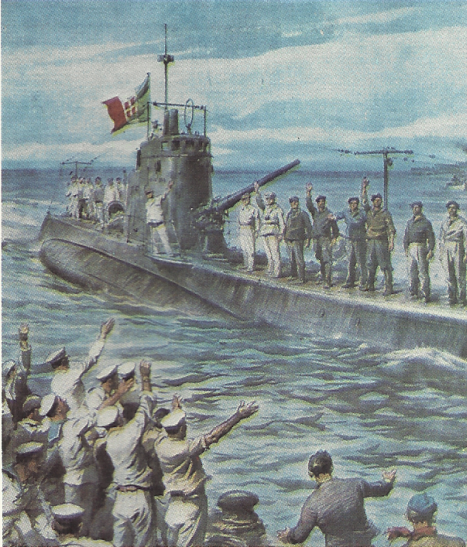
Painting of the Archimede back from a mission in the atlantic
although the action of U-Boats in the Atlantic has been well studied, the Italian force was mostly “left in the dark”, gaining little from October 1940 to May 1941 but improving as coordination with German HQ at Lorient was at last established from June 1941 to July 1943, mirroring the good performances of Italian troops in North Africa under Rommel’s command. Instead of “wolfpacks” attacking the convoys by night, the Italian submarines at first operated alone, attacked in daylight.
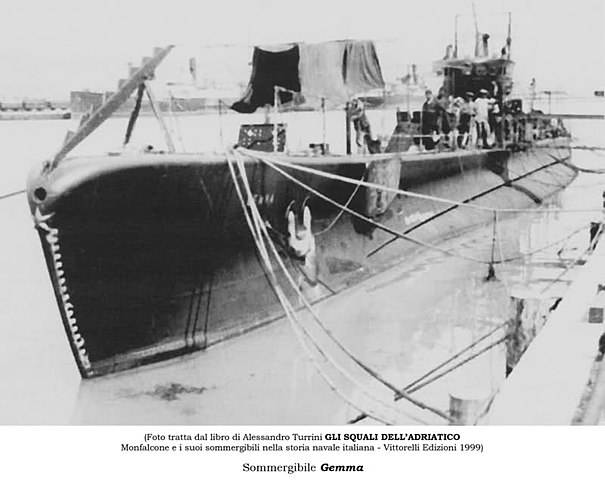
Submarine Gemma
Some long-range oceanic Italian submarines also operated on the US East Coast under the BETASOM command and were possibly the most successful. The Leonardo Da Vinci (a Marconi class submarine) sank 120.200 tonnes, the best non-German submarine of the war.
32 boats served in all in the Atlantic, at some early point, as many, if not more than U-boats. Half later returned to the Mediterranean or were converted as transports for the Far East. In total, Italian submarine operations in the Atlantic cost the allies some 109 allied merchant ships (593,864 tons).
It also should be surprising to some that if many German U-boats were lost in the Gibraltar strait, no Italian submarine was ever sunk while sailing towards Bordeaux. The local command was named BETASOM (“Beta” for Bordeaux and “Som” for Sommergibili), operating 27 oceanic submarines in early 1941. However German and Italian submarines could not coordinate their attacks, because of the diverging tactic (daylight attacks for the Italians, night attacks for the germans) but moreover the absence of a liaison or German communication officer on board Italian boats. Instead, if an Italian submarine was to spot an allied convoy, the report was send to Bordeaux command, then to Paris German naval command, then to Lorient, and only then to German submarines in the area. More often than not, the convoy was long gone when it happened.
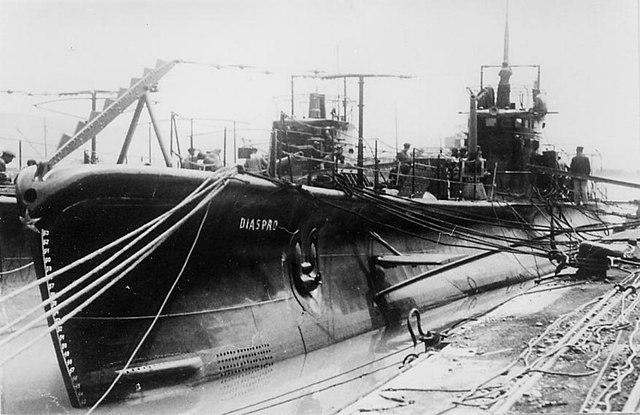
Submarine Diaspro
Nevertheless, with time, more Italian captains trained with German U-boats, following the path of Primo Longobardo, one of the most successful Italian submarine commander of the war. Also there was coordination in what areas should be covered, and the Italians operated around the Azores, South Atlantic, especially the far away Brazilian shipping lanes. The were also perfectly able to reach the Caribbean and hunt in the gulf of Mexico if needed. Another not well-known aspect of Italian submariners was their expertise in AA defense. Being larger and slower to dive, Italian submarines when spotted by an aircraft in daylight preferred to fight rather than to dive. One can say however, than the twin 8mm Breda machin-guns were a rather poor way to scare an enemy strafing plane coming from a mile away at at 400+ kph. This limitation was never corrected whereas the Italians had a very potent medium-range, fast and hard-hitting AA gun, the Breda mod.35 20 mm.
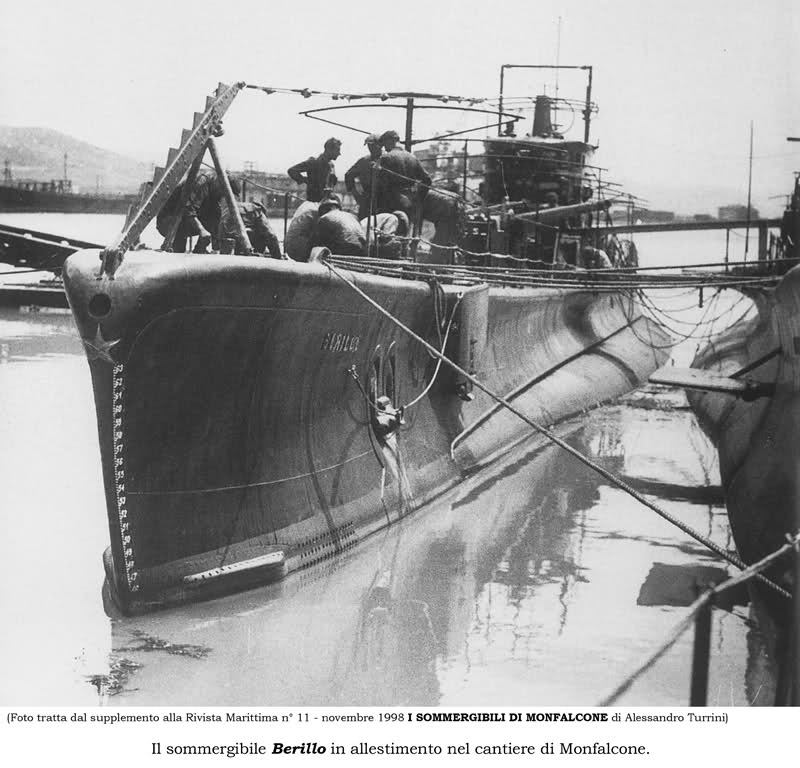
Submarine Berillo
Italian submersible aces
Archimede
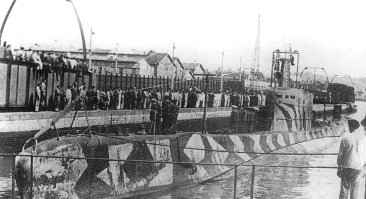
Archimede before conversion in 1943 as a transport, camouflaged. She was one the most succesful Italian submarine.
Leonardo da Vinci

The Leonardo da Vinci carried out 11 war patrols, sinking 17 ships of 120,243 GRT (including the liner RMS Empress of Canada). Captain, Lt. Gianfranco Gazzana-Priaroggia became Italy’s leading submarine ace and a war hero well exploited by Italian and German propaganda alike. The Italian Navy HQ was planning to use her on a raid on New York, but she was sunk before the operation in 1943. “Ursus atlanticus” sank more than 90,000 tons of shipping in a short while. Although some submarine captains of all nationalities committed atrocities, other showed their humanity such as the succesful captain Salvatore Bruno Todaro of the Commandante Cappellini, carrying survivors to land them safely ashore on the Azores.
Luigi Torelli
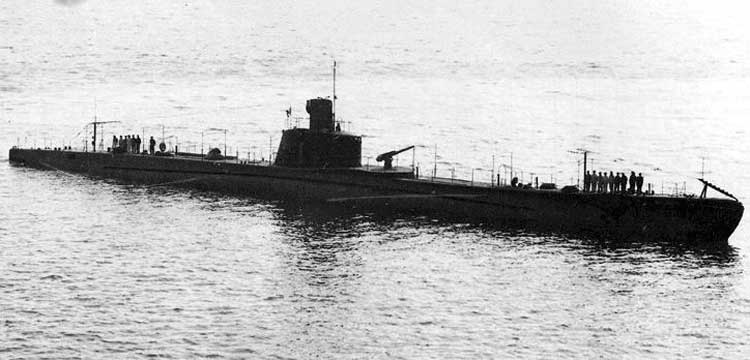
This other successful Marconi class submarine (launched January 6, 1940) slept through Gibraltar to join Bordeaux and sank seven enemy vessels for a total of 43,000 tons. She participated in an Operation and later in December 1941, saved the stranded crew of German raider KMS Atlantis.
She operated off the coast of Brazil, and later was attacked and damaged by Sunderlands. Back in Bordeaux she was converted as a transport sub, her torpedo tubes converted into extra fuel tanks and large holds constructed in place of the torpedoes were.
On June 14, 1943 she left Bordeaux with a German engineer, two civilian mechanics and a Japanese Colonel Kinze Sateke formed as a telecommunications expert bound to Singapore. Because the King deposed Mussolini at home, the submersible was captured by the Germans and the crew threw in a POW camp, only to reenlist to join the puppet fascist Republic of Salo later.
When Germany surrendered, UIT-25 was captured by the Japanese and served until the end of the war as I-504 with a mixed crew including Italians, Germans, and Japanese sailors and officers, a true testimonial of the axis at sea !
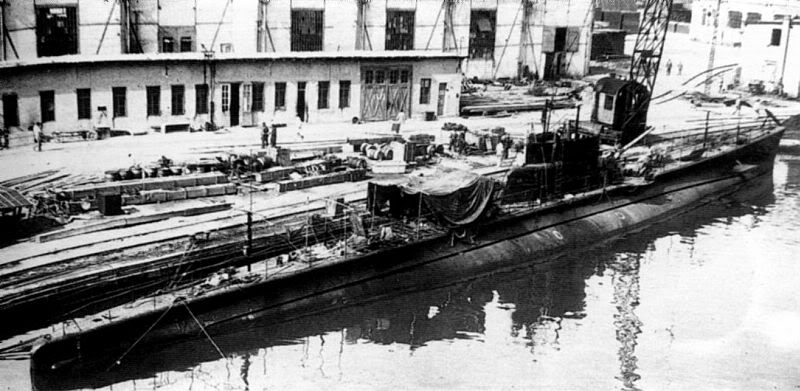
Italian submarine Corallo at Bordeaux (BETASOM).
Round the world: Italian transport subs
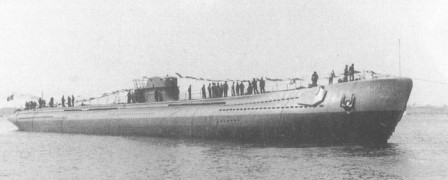
This chapter is often forgotten, contrary to the German large oceanic U-boats that bring in at the end of the war, and according to the iron pact, German engineers and plans for new jets and revolutionary weapons. But well before that in February 1943 a conference between Hitler and Dönitz about the high losses of German surface ships carrying war materials to and from the Far East ended with the decision to convince the Italians to stop using their larger submarines in the Alantic and rather convert them to this new task.
The first plan called Aquila, called for the conversion in six weeks at Bordeaux of ten Italian submarines with 150 tons of cargo. In compensation, the German would deliver ten Type VIIC for the Bordeaux Italian squadron. In between, two were sunk, Archimede and Leonardo da Vinci.
In May-June, five sailed, loaded with spare torpedoes and ammunitions in order to constitute Gruppe Monsun, an intermediary U-Boat base to resplesnish the boats for the Far East, but the last two were in Bordeaux ready to depart whn the italian Armistice was announced. Thie became a German operation, called Merkator. Eventually only three converted Italian submarines managed to reach Singapore in July and August 1943, they were all lost and never made it home.
The other part of the plan was to built dedicated submarines. The Italians created precisely for this task a serie that had seen little exposure. This was the “R” class, named after the lead boat, Romolo.
The program was unlike anything else the axis planned, and only because of limited industrial resources, two out of 12 boats started were completed when the surrender came. The 10 remaining boats were scuttled incomplete and scrapped after the war.
The Romolo/Romulus and Remo/Remus (the mythical founders of Rome) were giants compared to much Italian submarines, 86 m long for 7.86 wide and 2,560 tonnes. They could carry 600 tonnes, the nominal weight of a coastal submarine, and were armed with the minimum, two 450 mm tubes and 20 mm Breda AA guns.
But most important they were capable of a range up to 12,000 nautical miles (22,000 km; 14,000 mi). However despite their promises, both were lost en route in July 1943, never making it out of the Mediterranean.
The plan here was to built blockade running transport submarines, the same idea the Kaiserliches Marine tried in WW1 with the Deutschland when the US was still neutral. With the British locking the eastern access via the Suez canal, there was just one possibility for the Italians to carry goods to Japan and vice-versa as rubber tungsten and tin were in short supply from 1942. Via the dangerous Gibraltar strait.
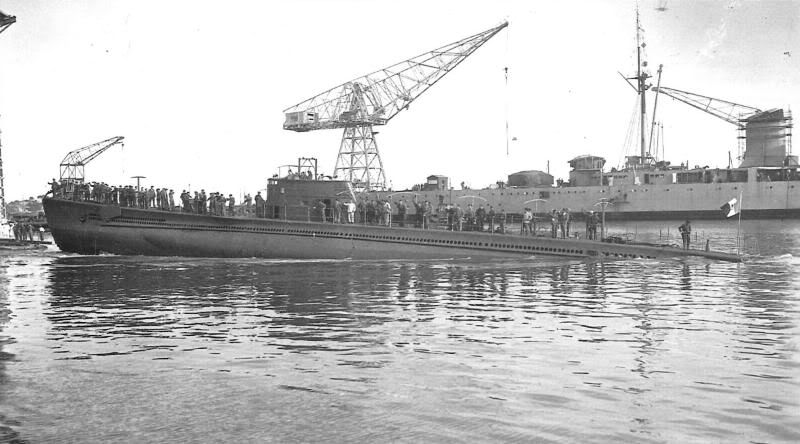
The launch of Onice
Italian Spec Ops: Midget and special crafts
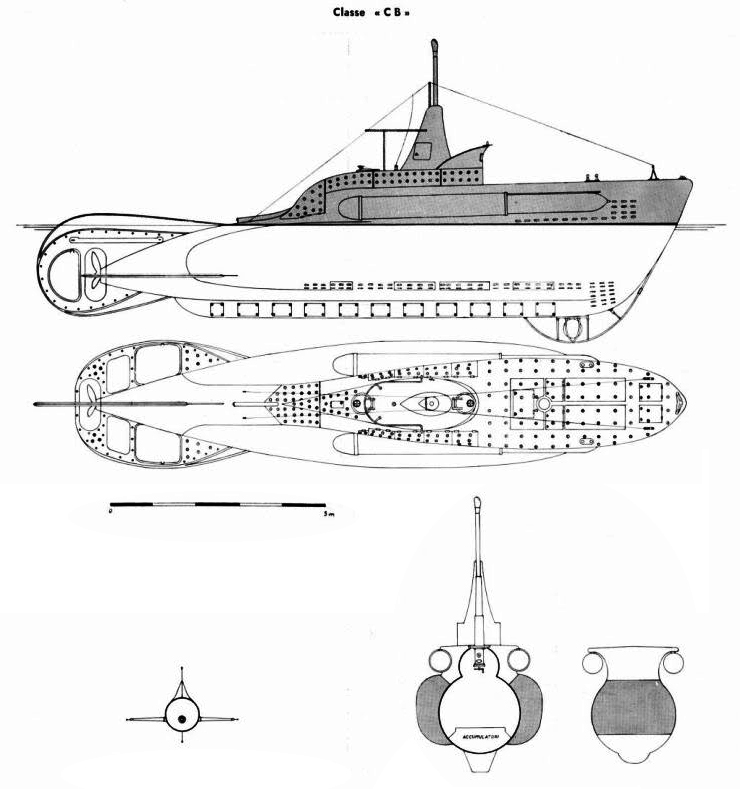
Original Schematics of the CB class midget submarines
In the Mediterranean, an obvious target soon appeared to the Italian naval staff: The major British naval installations at Gibraltar, Malta, Alexandria and Cyprus. Alongside sinking the HMS Bonaventure, HMS Calypso and HMS Coventry in 1940-41, dozens of merchantmen were also sank, however, allied breaking of Axis codes soon rendered operations difficult. Thus, the Italians turned to night operations with less visible means. This not was the start of spec-ops for the Italians, though, since they already had the dreadful MAS-boats, engineered the Grillo, sort of tank/torpedo boat, and used frogmen during and after the war, sinking among other the battleship Viribus Unitis in Pola, passing overnight to the new state of the Balkans. Also, just like the Germans an British, they developed midget submarines for covert operations, the earliest being ww1 boats.
Italian midget submarines in action
The idea of midget submarines was not new: In WW1 already, the X-crafts were 1917 coastal minelayers bbuilt by Ansaldo at Sestri, while the Alfa were another pair of 6 meters boats created in 1912 for the Italo-Turkish war, built in secret at Venice to monitor and guard the port entrance. The “A” class were first the proper midget boats, 36 tonnes boats, six designed by Edgardo Ferrati and built in La Spezia for harbour defence. They were to be posted at Ancona and Brindisi and also Venice, to replace the Alfa and Beta, discarded in 1915. The “B” class built in 1916 were three 46 tonnes boats, basically improved versions of the first, testing motors configurations for a longer range and better performances. While the first had their torpdoes in external cradles, the B class had them in proper tubes. They could be also carried by rail. The construction of the next B4 to B6 was cancelled. By 1920 they all had been scrapped, since their intended role was the defence of eastern adriatic ports.
Italian frogmen against battleships: Decima Flotiglia MAS
Perhaps the most famous single naval Italian unit of the war, the 10th assault vehicle flottilla also known as Decima Flottiglia MAS (for “Mezzi d’Assalto”), developed a kind of weapon aimed at ports. The goal was to pass defenses and operate within enemy warships, in order to sink them by explosives. Basically this was the work of frogmen, but they had to crosse large distances to get to the point of action, and therefore special crafts had to be designed.
In the late 1930s, these were modified torpedoes, with electric motors. They were suppose to just carry the frogmen underwater up to the delivery point, alongside their explosive payload. In all, using these crafts, frogmen carried by speed boats, or explosive speed boats (such as those which sank HMS York), this unit claimed five warships (72,000 GRT) and 20 merchant ships (130,000 GRT), one of the best record of the Regia Marina.
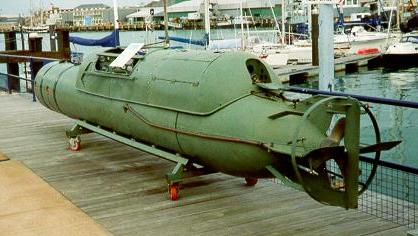
One man in particular was made famous by deploying them: Prince Junio Valerio Borghese, captain of the submarine Sciré. He led the famous attack that saw these “Maiales” or “pigs”, human torpedoes, leading a successful raid in December of 1941 at Alexandria, disabling for month the battleships HMS Queen Elizabeth and HMS Valiant. Two capital ships, very important to the Royal Navy to secure Suez, has been written off for more than half a year, whereas all the Regia Marina surface fleet failed.
The same captain led another attack at Gibraltar in September, sinking three enemy ships. Then from Algeciras, the Olterra, an old tanker converted with a submarine hold, launched more attacks on Gibraltar in December of 1942, sinking two ships and damaging two more and just before the armistice, yet another two British freighters and an American Liberty Ship. After the Italian government decided to swap to the Allies, as did most loyal submariners and officers, some die-hard fascists decided to follow a German-backed Mussolini and the RSI, such as Prince Borghese.
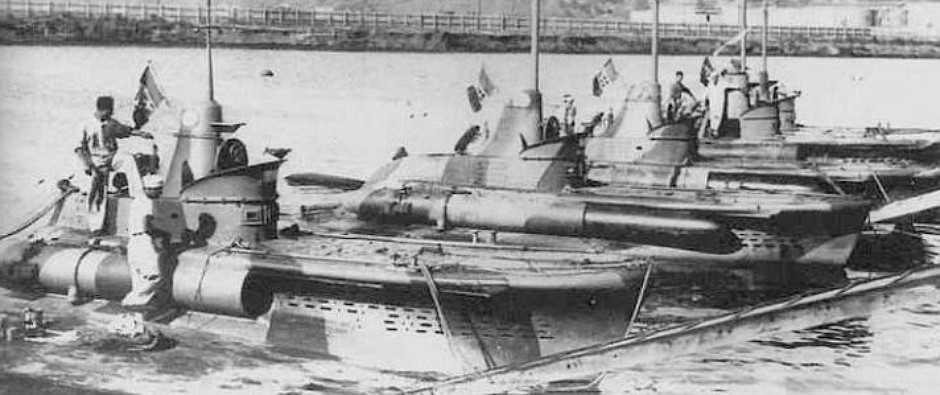
camouflaged CB class units in the black sea. Credits HI Sutton – Covert shores. It is little known that a number of Italian submarines operated against the Soviets, and Western analysts seem to believe that the latter obtained some of these well-engineered midget models in this theater after the war, having five back into service in 1944.
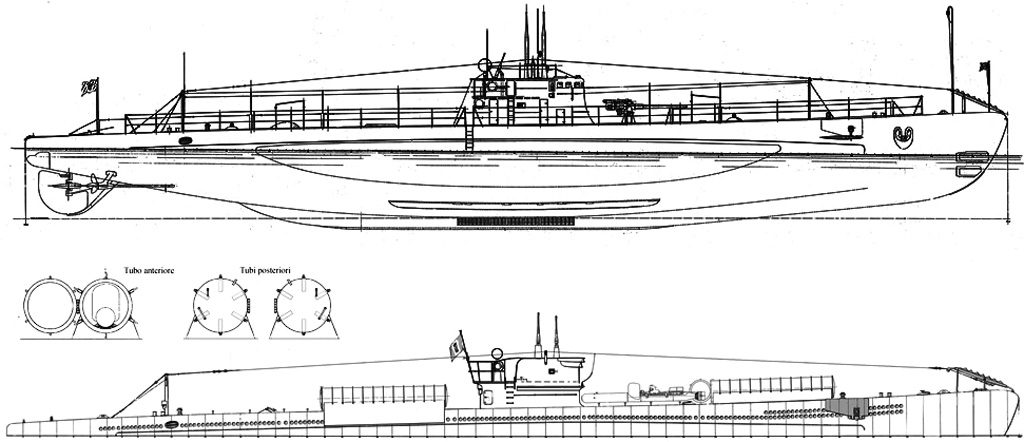
“Spec Ops” converted submarines Gondar and Neghelli. Above, their original appearance, below, their final appearance after conversion.
Italian submersibles into German service
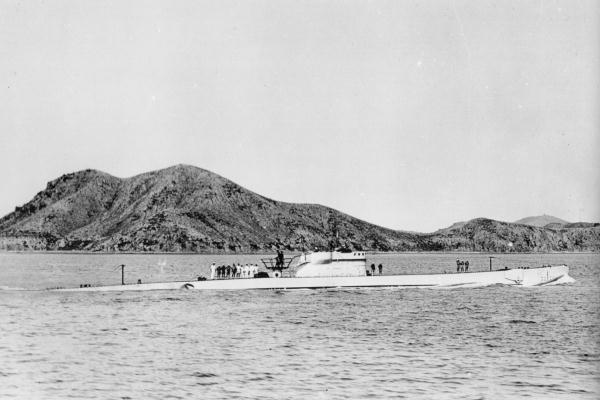
German UIT-25 in 1944
in all, the Germans captured some 40 Italian submarines. These were called the “UIT” series (for “Unterseeboote Italienisch”). Not all were operated however: Indeed the UIT-15, 16, 19 and 20 were refloated sunken (scuttled) Italian Flutto-I types that were refittd in harbour when sunk by allied aviation.
The Flutto-II UIT-7 and 14 were not completed either. Midget subs of the CM type UIT-17 and 18 were also planned for service but apparently never operational. These were registered as 25 in all, including some R-class (R7-12) as UIT1-6, former Acciaio and Flutto boats, and also the transport sub Luigi Torrelli, or the coastal boats Capellini, Bagnolini, Guiliani, Finzi, Grongo and Nautilo.
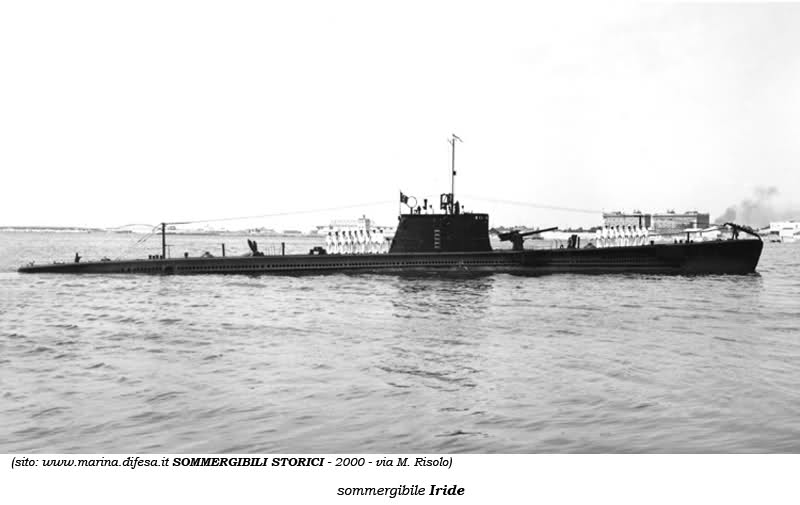
Foreign submersibles in Italian service
After the scuttling of Toulon, the Italians tried nevertheless to rise and repair as many ships as they could, including submersibles. However only one was repaired enough to be sent to Italy: The Henri Poincaré, which was towed to Genoa for refitting and full reparations. She was never pressed into service or renamed and scuttled by the Italians in September 1943.
More so, when the axis catpured Bizerta, there was there nine submarines in perfect order.
They were transferred in December 1942 to the Italian Navy: FR111 to FR117 and two more never renamed. Formerly these were the Requin type early oceanic subs Requin, Phoque, Espadon, Dauphin, but also the minelayer type Saphir and Turquoise, and the coastal ones nautilus and Circe, Calypso. FR113 was scuttled, FR 114-115 sunk by the Germans in September 1943. FR111 was sunk by an aircraft on 28.5.43 off Cape Passaro, FR116 and 117 were scuttled in May 1943, and Nautilus & Calypso sunk by an air raid on 31.3.43.
Also the Italians captured the Yugoslav Osvetnik and Smeli that were pressed into service as Francesco Raimondo and Antonio Baiamonti. Hrabi, also captured, was never back into service.
Italian submarines by class
H class coastal submersibles (1916)
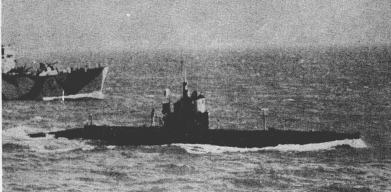
The great paradox here is that these eight submarines fought the British in WW2, but they were of Canadian construction Vickers Montreal, on a British-American design of Electric Boat with American parts. They were of excellent construction, reliable and very sturdy, with an electrical power which exceeded that of the diesel and they were capable of diving beyond 80m, way below that average Italian submarines, less than 50m. Reloading time was very short, as they were able to fire four torpedoes in two volleys after 5 seconds. Launched in 1916-1917 after being ordered by the Italian government to add their weight to the operations in the Adriatic, they were still in service in the 1920s.
The only change consisted in adding a single 3-in deck gun. H5 was sunk by error in 1918, H3 was stricken in 1937 and H7 in 1930 but the others were still operational in 1939. H6 an H8 were sunk in action, the other survived until 1947. The first was sunk after the armistice at Bonifacio, Corsica by the Germans and the second in la Spezia in May 1943 by allied aviation.
Specifications:
The same as the British H class submarines
X class coastal submersibles minelayers (1917)
(Picture Conways page 278)
This class was named after the “X” code for minelayers in Italian nomenclature, and designed by engineer Curio Bernardis, based on the German UC-12, built fir the Austrian navy, sunk and later captured and refloated by the Italians, renamed X1 and in service until 1919. The system for embarking and laying mines was the same used by the Germans, but the mine compartment was made roomier to accept nine tubes for a total of 18 mines, of the Italian AE1916/125t type. Also Italian designed was the 3-in deck gun and two cage TTs for 17.7 in torpedoes were placed in the main flooding trunk. However, performance wise these boats were rather poor, slow and showing little agility. They were still in service in 1939 but both were laid up on 16 September 1940, never to see action during the remainder of the conflict.
Specifications:
403/467 tons, 42.6 x 5.5 x 3.1m, 2 shafts Sulzer diesels and Ansaldo electric motors 650/325 hp for 8.3 knots surfaced, 6.3 diving. Complement was about 23 officers and sailors
Links/Src
Conway’s all the world’s fighting ships 1921-1947
http://www.sommergibili.com/delfinoe.htm
http://www.regiamarina.net/detail_text.asp?nid=88&lid=1
https://en.wikipedia.org/wiki/Italian_submarines_of_World_War_II
http://www.sommergibili.com/indexen.htm
http://italianmonarchist.blogspot.com/2012/12/the-strange-case-of-luigi-torelli.html
reddit.com/r/WarshipPorn/comments/91g6lr/the_italian_submarine_perla_sporting_her_camo/
https://en.wikipedia.org/wiki/Regia_Marina
https://apps.dtic.mil/dtic/tr/fulltext/u2/a613508.pdf
https://forum.axishistory.com/viewtopic.php?t=210819
https://www.ibiblio.org/hyperwar/USN/ref/AxisSubs/index.html
Italian Oceanic submersibles (1927-43)
With much better range than coastal submersibles, these were based in Bordeaux from the end of 1940, but gradually moved their operating area (and later tactics, with better coordination with the Germans) in the South Atlantic. Some even became in 1942-43 transport submersibles bound to Japan.
Ballila class oceanic submersibles (1927)

The genesis of Balilla (also Toti, Millelire, Sciesa) comes from the Admiralty’s desire to build a fleet of submarine cruisers able to operate in the Red Sea and in the Indian Ocean from the Italian colonial bases in Africa. ‘is. The model was, as for other European nations, the last submersibles Germans, especially the U120, transferred to war damage in 1919 and whose Balillas were largely inspired.
Naturally endowed with a double hull, they were very sturdy, the Millelire diving to more than 120 meters in crash tests. Their Fiat diesels used for cruising, were directly based on WW1 German MAN Diesels. They could travel 13,000 nautical miles. Four boats were launched in 1927-28 and completed in 1928-29. Considered to be too big to operate in the Mediterranean, and despite some success, on patrol (Toti sank HMS Rainbow in 1940 for example), they were all converted into tankers and survived the war but the Sciesa, sunk and scuttled at the end of 1942 in Tobruk.

Specifications
Displacement: 1,427 t. standard -1 874 t. Diving
Dimensions: 86.5 m long, 7.8 m wide, 4.7 m draft
Machines: 2 propellers, 2 diesel diesels, 2 electric motors Savigliano, 4900/2200 hp.
Top speed: 16 knots surface / 7 knots diving
Armament: 1 x 120, 2 x 13.2 AA MGs, 6 x 533 mm TTs (4 bow, 2 stern, 16 torpedoes)
Crew: 77
Ettore Fieramosca (1929)
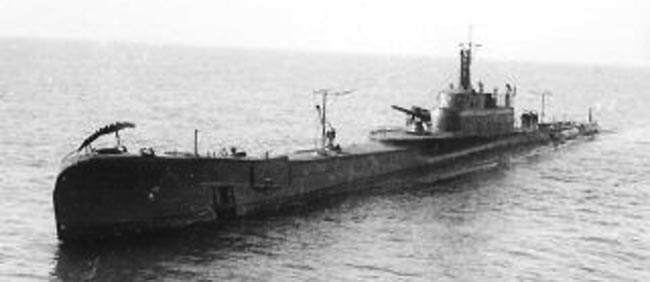
This rather large submarine was designed by Bernardis to carry a small floatplane for reconnaissance, stored in an extension of the conning tower, like the French Surcouf. however the hangar was removed in 1931 and her old 120 mm/27 gun replaced by a 120mm/45. Of single-hull construction with large bulges, she was more stable than the ballila, but still quite slow to dive, and with poor agility underwater. She was never able to reach her designed speed of 19 knots. Range was 5000 miles, but her carrer was short: After a few missions she suffered a fatal battery explosion in mid-1940, and was laid up and never repaired. She was broken up in 1946.
Specifications
Displacement: 1,530 t. standard -2 094 t. Diving
Dimensions: 83.97 m long, 8.3 m wide, 5.11 m draft
Machines: 2 propellers, 2 Tosi diesel, 2 Marelli electric motors, 5200/2300 hp.
Top speed: 15 knots surface/8 knots submerged. Oil 150 ton.
Armament: 1 x 120, 4x 13.2 AA MGs, 6 x 533 mm TTs (4 bow, 4 stern, 14 torpedoes)
Crew: 78
Archimede class oceanic submersibles (1933)
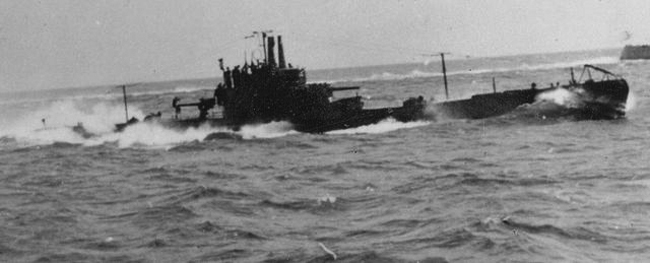
Built in Tosi in 1931-35, these four units designed by the engineer Cavallini were only two in 1940, Archimede and Torriceli having been transmitted to the Spanish Nationalist fleet in 1937. They were enlarged versions with more of autonomy of Settembrini. The Galilei was captured in the Red Sea by the armed trawler HMS Moonston in June 1940 and used by the RN as a training submarine. The Ferraris was sunk by a plane then a destroyer escorting a convoy off Gibraltar on October 25, 1941.

Specifications
Displacement: 970 t. standard -1 240 t. Diving
Dimensions: 70.5 m long, 6.87 m wide, 4.12 m draft
Machines: 2 propellers, 2 Tosi diesels, 2 Marelli electric motors, 3000/1100 hp.
Top speed: 17 knots surface/8 knots dive
Armament: 2 of 100, 2 of 13.2 mm AA, 8 TLT 533 mm (4 bow and 4 stern and 18 torpedoes)
Crew: 55
Glauco class oceanic submersibles (1933)

Author’s rendition of the Otaria, Glauco class as built.
Glauco and Otaria had been ordered at the CRDA shipyard of Montfalcone by Portugal in 1931 under the name of Delfin and Espadarte. Canceled shortly thereafter, they were taken over by Regia Marina, and both units were commissioned in 1935 and 1936. Glauco was scuttled in front of Gibraltar, badly damaged by a destroyer, and the Otaria served as a transport and patrolled. Mediterranean from 1941 to 1943. She survived the war.

Specifications
Displacement: 1,054 t. standard -1 305 t. Diving
Dimensions: 73 m long, 7.2 m wide, 5.12 m draft
Machines: 2 propellers, 2 diesel diesels, 2 electric motors CRDA, 3000/1200 hp.
Top speed: 17 knots surface / 8 knots dive
Armament: 1 cannon of 100, 2 mitt. 13.2 AA, 8 TLT 533 mm (4 bow, 4 stern, 14 torpedoes)
Crew: 58
Pietro Micca (1935)

The Micca, simply put, was Italy’s largest prewar submarine, with a displacement around 1545t/1940t. Designd by engineer Cavallini as a cruiser and minelayer of the same concept than British Porpoise, she can only carry 40% of her mine load and was slower, but she was better armed and had a good range of around 12,000 nm at 8 knots. She was built and launched at Tosi in 31.3.1935 and in 1940 undertook a few minelaying missions. She was eventually torpedoed by Britsh submarines HMS Trooper in the strait of Otranto.
Specifications
Displacement: 1,545 t. standard -1,940 t. Diving
Dimensions: 90.30 m long, 7.7 m wide, 5.3 m draught
Machines: 2 shafts Tosi diesels, 2 Marelli electric motors, 3500/1500 hp.
Top speed: 15.5 knots surface/8.5 knots sub
Armament: 2 x 120mm/45, 4 x 13.2 AA, 6 TT 533 mm (4 bow, 2 stern, 10 torpedoes), 20 mines
Crew: 72
Calvi class oceanic submersibles (1935)
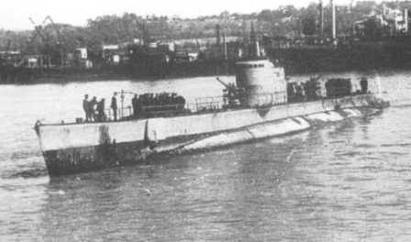
Giuseppe Finzi, Calvi class
These are modernized versions of Balilla. The hull was enlarged and optimized for better stability. Engine power was sacrificed in favor of two more torpedo tubes and an extra gun. This class had a slightly lower speed but a better radius of action, 13,400 nautical miles. Their crushing depth was 100 meters. Built at OTO Muggiano, there were three: Calvi, Finzi and Tazzoli. The first two were scuttled (Atlantic in 1942 and Bordeaux, the latter with a German crew late 1943) and Tazzoli disappeared at sea in May 1943 for some unknown reason.

Specifications
Displacement: 1,525 t. standard -2,028 t. Diving
Dimensions: 84.30 m long, 7.7 m wide, 5.2 m draught
Machines: 2 propellers, 2 diesels Fiat, 2 electric motors, 4400/1800 hp.
Top speed: 17 knots surface/8.5 knots sub
Armament: 2 x 120, 4 x 13.2 AA MGs, 8 x 533 mm TTs (4 bow, 4 stern, 16 torpedoes)
Crew: 77
Foca class oceanic submersibles (1937)

Designed by the engineer Cavallini, they were the last submersibles minesweepers Italians; They could dive more than 100 meters and had a range of 8500 nautical miles. They did not have tubes at the stern, and their stern was arranged so as to be able to wet the mines contained in long longitudinal silos. In 1941-42, their cannon was put back in front of the kiosk. They had been completed in 1938-39, and the Foca was sunk on a mission to Haifa in October 1940. The other two survived the conflict.

Specifications
Displacement: 1,305 t. standard -1 625 t. Diving
Dimensions: 82.85 m long, 7.17 m wide, 5.20 m draught
Propulsion: 2 propellers, 2 diesels Fiat, 2 electric motors Ansaldo, 2280/1250 hp.
Top speed: 16.1 knots surface/8 knots sub
Armament: 1 x 100 mm, 4 x 13.2 mm AA MGs, 6 x 533 mm TTs (bow), 36 mines
Crew: 60
Marcello class oceanic submersibles (1937)
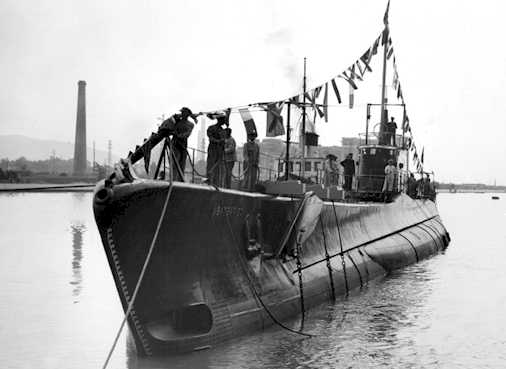
Barbarigo
The 11 Marcello-class ships designed by Bernardis were oceanic submarines launched in 1937-39. They were fast enough and maneuverable in diving, but suffered from an excessive roll, which the adoption in 1941-42 of a smaller kiosk solved. They were sunk or lost during the conflict, starting with the Provana, which was destroyed by the French aviso La Curieuse off Oran June 17, 1940. The class comprised the Barbarigo, Dandolo, Emo, Marcello, Mocenigo, Morosini, Nani, Provana, Veniero, Cdt Capellini and Cdt Faa di Bruno. For some authors they were the best Italian submarines of the war.
The Barbarigo and Cappellini were converted into transports to Japan at the end of 1943 and the Cappelini was seized in November by the Japanese at Sabang, Barbarigo having been sunk off Spain. The Cappellini was transferred to the Kriegsmarine, becoming IUT-24, then taken over by the Japanese in March 1945 and renamed I-503. But she did not operated long because of the lack of fuel, she surrendered to the Americans in Kobe on September 2nd.

Specifications
Displacement: 1,043 t. standard -1 290 t. Diving
Dimensions: 73 m long, 7.20 m wide, 5.10 m draft
Propulsion: 2 propellers, 2 diesels Fiat / CRDA, 2 electric motors CRDA, 3600/1100 hp.
Maximum speed 17.4 knots surface / 8 knots diving
Armament: 1 cannon of 100, 4 mitt. 13.2 mm AA, 8 TLT 533 mm (4 bow, 4 stern, 16 torpedoes)
Crew: 57
Brin class oceanic submersibles (1938)
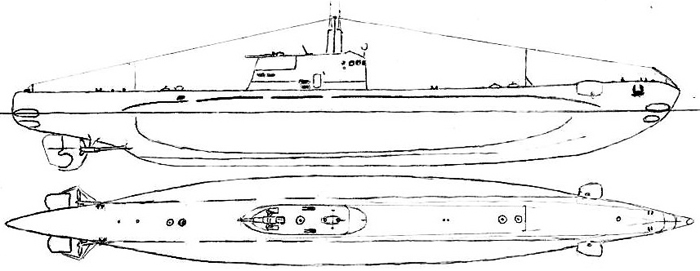
Schematics of the Brin class
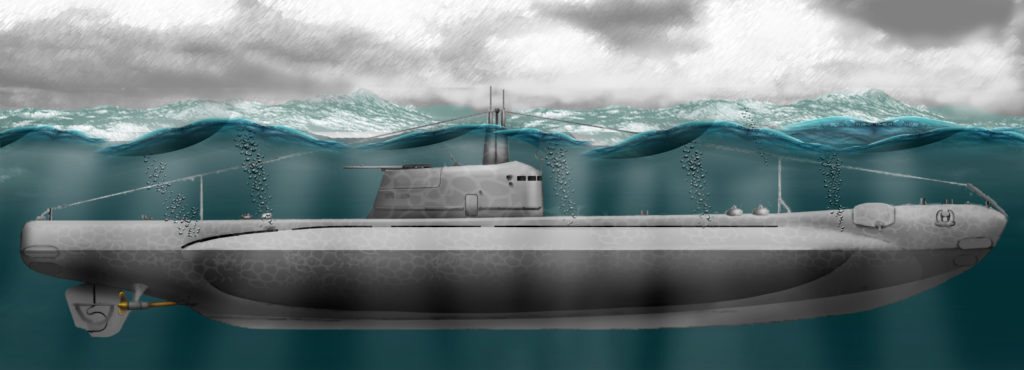
Derived from the Archimede, these 5 submersibles built by Tosi were completed in 1938-39. Two replaced the units of the previous class transferred to the Spaniards. They were a little heavier and their only gun was placed in the back of the Kiosque, configuration proper to the Italians.
They were all sunk by war events, the Toricelli for her part during a surface duel against three destroyers and an English sloop in the Red Sea, and later scuttled to avoid capture. The Brin survived the war and was discarded in 1948.

Specifications
Displacement: 1,000 t. standard -1 245 t. Diving
Dimensions: 72.47 m long, 6.68 m wide, 4.5 m draught
Propulsion: 2 propellers, 2 Tosi diesels, 2 Ansaldo electric motors, 3400/1400 hp.
Top speed: 17.3 knots surface/8 knots sub
Armament: 1 x 120 mm, 4 x 13.2 mm AA, 8 TLT 533 mm (4 bow, 4 stern and 16 torpedoes)
Crew: 58
Liuzzi class oceanic submersibles (1939)
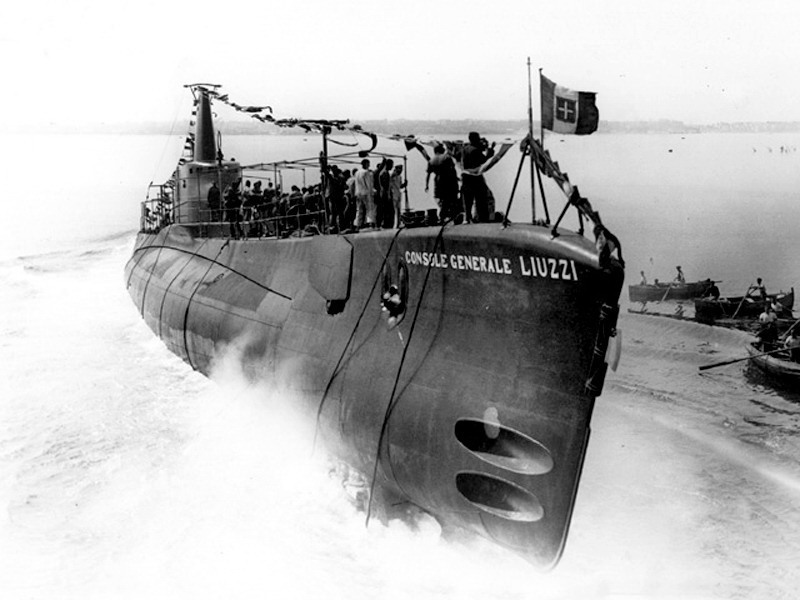
Launch of the Liuzzi at Tosi Yard
These four units built at Tosi were virtually enlarged Brin. They were launched in 1939-40 and their cannon was in the forward position. The Liuzzi was scuttled in 1940, after being disabled by the firing of several destroyers, the Tarantini was sunk by the HMS Thunderbolt in 1940, off the Biscay. The Bagnolini and Guiliani were used from January 1943 as transports to Japan. They were both captured at the surrender of Italy in November 1943, the latter in Singapore by the Japanese, and the first by the Germans in Bordeaux. They operated under the flag of Kriegsmarine (UIT-22 and 23), and sunk in 1944, UIT-23 by HMS Tally Ho in the Straits of Malacca and IUT-22 by an Australian Catalina off the Cape of Good Hope.

Specifications
Displacement: 1,148 t. standard -1,460 t. Diving
Dimensions: 76 m long, 7 m wide, 4.55 m draught
Propulsion: 2 propellers, 2 Tosi diesels, 2 electric motorsAnsaldo, 2500/1500 hp.
Top speed: 18 knots surface / 8 knots dive
Armament: 1 x 100 mm, 4 x 13.2 mm AA, 8 x 533 mm TTs (4 bow + 4 stern, 12 torpedoes)
Crew: 58
Marconi class oceanic submersibles (1939)
These are six units designed by Bernardis in line with Marcello, but with more length and less width, and a more powerful engine to reach better surface speed. In order to optimize the stability, a gun was removed and reduced as well as their conning tower. Four were sunk or lost in action in 1941, the Leonardo da Vinci in 1943 (the best Italian submarine of the war), and the Toricelli was converted to Japan, captured in Singapore in 1943, briefly used by the Germans as ITU-28 and in April 1945, shortly before capitulation, transferred to the Japanese, becoming I-504. She was damaged and went to Kobe yard in September 1945. She was later dynamited and dismantled on situ by the Americans in 1946. For most authors, this was the overall best class of italian submarines of the war.

Specifications
Displacement: 175 t. standard -1 465 t. Diving
Dimensions: 76.5 m long, 6.8 m wide, 4.7 m draft
Propulsion: 2 propellers, 2 CRDA diesels, 2 Marelli electric motors, 3600/1500 hp.
Top speed: 17.8 knots surface / 8.2 knots dive
Armament: 1 x 100 mm (4 × 2), 4 x 13.2 mm AA, 8 x 533 mm TTs (4 bow, 4 stern)
Crew: 57
Cagni class oceanic submersibles (1940)

Old rendition of the Cagni (Atlas Editions)
This was a class of four large submersible cruisers intended to operate in the Red Sea and the Indian Ocean against the English merchant traffic. As a result, the focus was on the number of torpedo tubes (14, the absolute record for a ww2 submarine) and reserve torpedoes on board, with 450 mm tubes for civilian ships, instead of the usual 533 mm (21 in) “for war”.
Their superstructure was reduced to a German style conning tower, and they had two guns. They made long cruises in 1941, the Cagni remaining in the South Atlantic for 4 months and a half. Named after admirals, they had an autonomy of 13,500 nautical miles. Saint Bon and Millo were sunk by English submarines, the Caracciolo scuttled at Bardia and the Cagni surrendered to the allies in 1943, being used for training until 1948.
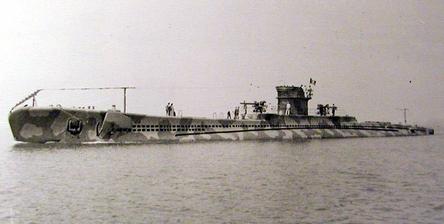
Amiraglio Cagni, limited copyright image used for visual identification of the object under fair use. Source: http://www.sommergibili.com/cagnie.htm
Specifications
Displacement: 1,653 t. standard -2 136 t. Diving
Dimensions: 88 m long, 7.7 m wide, 5.7 m draught
Propulsion: 2 propellers, 2 diesels CRDA, 2 electric motors CRDA, 4370/1800 hp.
Top speed: 17 knots surface/8.5 knots sub
Armament: 2 x 100 mm, 4 x 13.2 mm AA, 14 TLT 450 mm (8 bow, 6 stern, 36 torpedoes)
Crew: 85
Italian Coastal submersibles (1927-43)
In general around 600 tons, with a weak range, these were instended to operate in the confines of the Mediterranean and were arguably far less successful than oceanic ones, despite from 1942 an abundance of potential targets. Their defaults were know, poor speed and agility, a large conning tower that slowed them down when diving, low crushing depht. They were however made for numbers, on a budget and made the bulk of Italian submarines when the war broke out.
Mameli class coastal submersibles (1927)

These 4 units designed in 1924-25 by Cavallini and TOSI were the prototypes of a new series of ocean submersibles adapted to the Mediterranean as to the Atlantic. They were largely inspired by the in-depth examination of German units transferred to war damage, with immersion capabilities and much greater strength.
As such, these units could fall below the bar of 115 meters. They lacked stability, which was corrected by widening the tick, at the cost of a significant reduction in their speed. In 1942, the three surviving units were equipped with new 4000 hp diesels, recovering their expected speed. The Capponi was sunk in 1941 by the submersible HMS Rorqual.

Specifications
Displacement: 810 t. standard -993 t. Diving
Dimensions: 64.6 m long, 6.5 m wide, 4.3 m draught
Propulsion: 2 propellers, 2 TOSI diesels, 2 CGE electric motors, 3000/1100 hp.
Top speed: 15 knots surface/7.5 knots dive
Armament: 1 x 102 mm, 2 x 13.2 mm AA, 6 x 533 mm TTs (4 bow, 2 stern, 10 torpedoes)
Crew: 49
Pisani class coastal submersibles (1927)
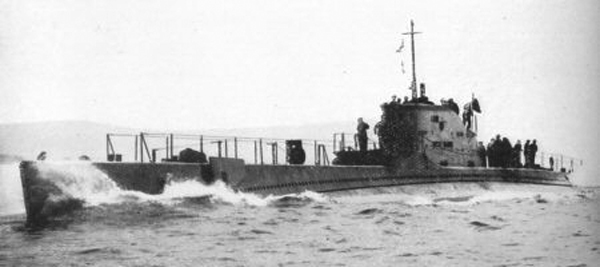
The clas comprised the Giovanni Bausan, Marcantonio Colonna, Des geneys, and Vettor Pisani, launched 1927-28 and completed in 1929. They were classic Bernardis Types, developed in parallel to the Mameli to comparatively test features. They hd better designed speed of 18.75 knots surfaced despite having the same machinery, while radius was increased by carrying 30% more fuel at 5000 nautical miles.
However they still had a poor transverse stability and had to be modified, which made their speed fall of two knots. Of little value they were all laid up on 16.4 1940 to free materials and men for better units. Bausan became a floating oil tank, and Des Geneys a battery charger. Pisani survived the war and was discarded in 1947.

Specifications
Displacement: 866 t. standard -1040 t. Diving
Dimensions: 64.6 m long, 6.5 m wide, 4.3 m draught
Propulsion: 2 propellers, 2 TOSI diesels, 2 CGE electric motors, 3000/1100 hp.
Top speed: 15 knots surface/7.5 knots sub (after mods)
Armament: 1 x 102 mm/35, 2 x 13.2 mm AA, 6 x 533 mm TTs (4 bow, 2 stern, 10 torpedoes)
Crew: 48
Bandiera class coastal submersibles (1929)
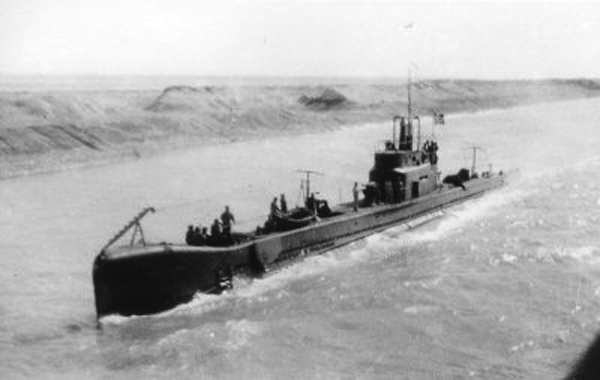
The class comprised Fratelli Bandiera, Luciano Manara, Ciro Menotti and Santorre Santarosa, built at CNT and OTO Muggiano and launched from august to december 1929. They were Bernardis improved Pisani with higher submerged speed, more TTs and a better endurance. Stability was low and bulged were added, reducing their top speed which was initially 17.5 knots. Endurance was 4750 nautical miles at 8.5 knots. They were modified again since it was discovered they were rather poor seaboats, plunging and plowing in heavy weather.
Shortly after completion they were given a higher freeboard oat the stem and improved buoyancy. Later on, their kiosk was replaced by a smaller one of the German style, at least on the Monara. Menotti had its 102 mm/35 gun replaced by a 100 mm/47 which had better range and reloading time. When the war in north africa reached a peak they were used to supply materials and supplies. Santarosa was grounded near tripoli in January 1943 while the other became training boats at home. Santarosa was later torpedoesd by MTB260 and scuttled.

Specifications
Displacement: 928 t. standard -1080 t. Diving
Dimensions: 69.8 m long, 7.3 m wide, 5.25 m draught
Propulsion: 2 shafts TOSI diesels, 2 CGE electric motors, 3000/1300 hp.
Top speed: 15 knots surface/8 knots sub
Armament: 1 x 102 mm/35, 2 x 13.2 mm AA, 8 x 533 mm TTs (4 bow, 4 stern, 12 torpedoes)
Crew: 53
Squalo class coastal submersibles (1930)
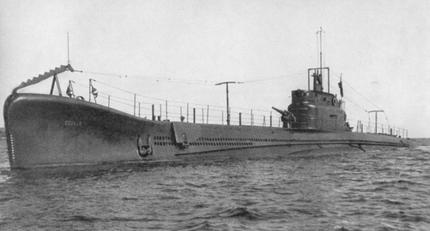
These were very close to the bandiera, nearly half-sisters, but larger overall. However their initial faults and modifications were the same. The class comprised the Delfino, Narvalo, Squalo and Tricheco, all built at CRDA Montfalcone and launched in January to September 1930. Starting with Squalo, they were fitted with a smaller conning tower. Three were lost: Delfino in 23.3.1943 accidentally off Taranto, Narvalo on 14.1.1943 off Tripoli and cuttled to avoid capture, and Tricheco by gunfire from destroyer HMS Pakenham, escort destroyer HMS Hursley and an aircraft on 18.3.1942.

Specifications
Displacement: 920 t. standard -1125 t. Diving
Dimensions: 69.8 m long, 7.2 m wide, 5.19 m draught
Propulsion: 2 shafts TOSI diesels, 2 CGE electric motors, 3000/1300 hp.
Top speed: 15 knots surface/8 knots sub
Armament: 1 x 102 mm/35, 2 x 13.2 mm AA, 8 x 533 mm TTs (4 bow, 4 stern, 12 torpedoes)
Crew: 53
Bragadin class coastal submersibles (1930)
A pair of coastal submersibles designed by Bernardis and built at Tosi, Marcantonio Bragadin and Filippo Corridoni, launched in July 1929 and March 1930. They were basically slow minelayer type completed in 1931 after many changes (they were laid down in 1927, so contruction spanned five long years). On trials, they show a tendency to plow heavily in high waves and they went back to drydock to be fitted a raised stem. Their two mine tubes were fitted aft but this proved not satisfactory on trials and while the stern was rebuilt, the tubes were moved further at the extreme stern. Endurance was good at 9000 nautical miles at 8 knots. The irony is that they were never used as minelayers but suppkly boats instead. They surrendered to the allies in 1943 and were stricken in 1948 after seeing little service postwar.
Specifications
Displacement: 965 t. standard -1068 t. Diving
Dimensions: 71.5 m long, 6.15 m wide, 4.9 m draught
Propulsion: 2 shafts TOSI diesels, 2 Marelli electric motors, 1500/1000 hp.
Top speed: 11.5 knots surface/7 knots sub, oil 41 tons.
Armament: 1 x 102 mm/35, 2 x 13.2 mm AA, 4 x 533 mm TTs (4 bow, 6 torpedoes), 16 to 24 mines
Crew: 55
Settembrini class coastal submersibles (1930)
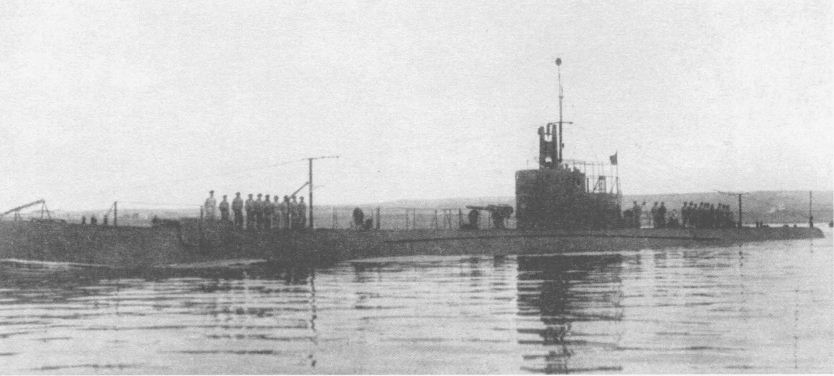
A pair of coastal submersible based on the Mameli design, but with stability bulges and other improvements added in the design. Luigi Settembrini waslaunched in 28.9.1930 and Ruggiero Settimo in March 1931, both at Tosi. They achieved their designed speed and seakeeping was good, endurance was 9000 nm at 8 knots. Both were extant at the capuitulation and joined the allies afterwards, but Settemrini was sunk by error in 15.11.1944 by US escort detroyer USS Frament in the western Atlantic.
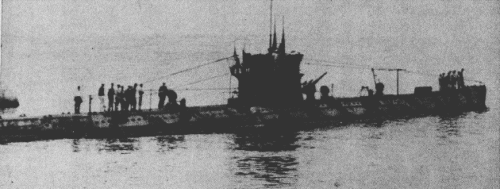
Top: Ruggero Settimo of the Settembrini class. Bottom: Godfredo Settembrini, date unknown.
Specifications
Displacement: 938 t. standard -1135 t. Diving
Dimensions: 69.11 m long, 6.61 m wide, 4.45 m draught
Propulsion: 2 shafts TOSI diesels, 2 Ansaldo electric motors, 3000/1400 hp.
Top speed: 17.5 knots surface/7.7 knots sub
Armament: 1 x 102 mm/35, 2 x 13.2 mm AA, 8 x 533 mm TTs (4 bow, 4 stern, 12 torpedoes)
Crew: 56
Argo class coastal submersibles (1936)
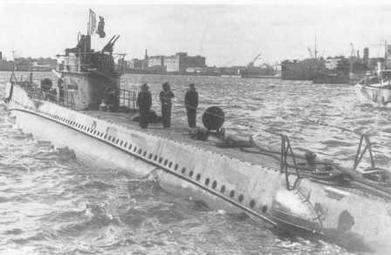
Last pair of coastal submarines testing features before large series. Designed by Bernardis on a modified Cavallini design, they were much smaller, and initially ordered in 1931 by Portugal on a tailored design. However the contract was cancelled while on construction. These boats were 780 tonnes, 63 m long with 6 TTS, moderately fast at 14 knots. But they were cheap. Work resumed in 1936 at CRDA Montfalcone after the Italian government took them over. They had a partial double-hull and resembled the standard 600 ton type, but armed with the modern 100 mm/47 and better AA, four 13.2 mm Breda MGs. Both were lost in 1943, Argo on 11.9.1943 scuttled in Montfalcone to avoid capture by the Germans and Vellela on 12.12.1943 by British sub HMS Shakespeare.
Specifications
Displacement: 780 t. standard -1000 t. Diving
Dimensions: 63.15 m long, 6.93 m wide, 4.46 m draught
Propulsion: 2 shafts TOSI diesels, 2 CRDA electric motors, 1500/800 hp.
Top speed: 14 knots surface/8 knots sub
Armament: 1 x 100 mm/47, 4 x 13.2 mm AA, 8 x 533 mm TTs (4 bow, 2 stern, 10 torpedoes)
Crew: 46
Argonauta class coastal submersibles (1931)
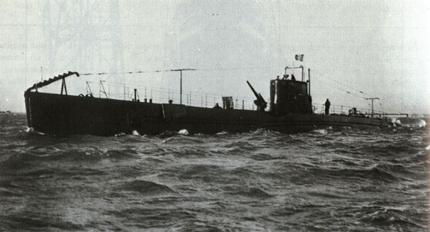
These seven units started in 1929-30 and completed in 1932-33 were the first designed by engineer Bernardis on the specifications of the admiralty demanding a 600 tons. This type of unit was cheaper and allowed mass production, without losing firepower. On the other hand speed and radius of action limited them to the Mediterranean (5000 nautical miles). Their operational depth was 80 meters. In 1941-42, the Medusa and Serpente received a kiosk of a smaller model. They were all sunk during the conflict, except the Serpente, scuttled in 1943, and the Jalae, struck off the lists in 1948.

Specifications
Displacement: 650 t. standard -800 t. Diving
Dimensions: 61.5 m long, 5.7 m wide, 4.7 m draft
Propulsion: 2 propellers, 2 CRDA / Fiat diesels, 2 CRDA / Marelli electric motors, 1200/800 hp.
Top speed: 14 knots surface / 8 knots dive
Armament: 1 guns of 100, 4 mitt. 13.2 AA, 6 TLT 533 mm (4 bow, 2 stern, 12 torpedoes)
Crew: 44
Sirena class coastal submersibles (1933)
These units, arranged in three subclasses, and ending in 1941-42 with the slightly different Acciao, had in common the same designer, the engineer Bernardis, on a standard of admiralty for submersibles with low autonomy 600 tons. She followed the previous class Argonauta (1931), but was slightly wider. The first subclass, Sirena, had 12 units, the second subclass, Perla, 10, and the third, Adua, 17. In 1941-43, their booth was modified on the model of the Acciao. The AA armament was sometimes modified, opting for a single or double 20 mm lookout. Almost all were sunk in action, and a number of them distinguished themselves in combat, including the Neghelli, the Axum or the Alagi.

Specifications
Displacement: 680 t. standard -837 t. Diving
Dimensions: 60.18 m long, 6.45 m wide, 4.78 m draft
Propulsion: 2 propellers, 2 diesels Fiat / CRDA / Tosi, 2 electric motors CRDA / Marelli, 1400/800 hp.
Top speed: 14 knots surface / 7.7 knots dive
Armament: 1 of 100 mm AA, or 4 of 13.2 mm AA (2 × 2), 6 TLT 533 mm (4 bow, 2 stern, 16 torpedoes.)
Crew: 45
Perla class coastal submersibles (1936)
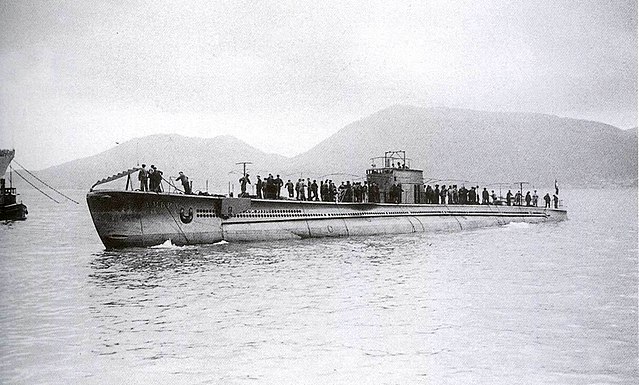
These ten boats named after gems (Ambra, Berillo, Corallo, Diaspro, Gemma, Iride, Malachite, Onice, Perla, Turchese) were built at OTO Muggiano, and CRDA Montfalcone, launched in 1936. They were virtually repeats of the 600-ton Sirena class. However in 1940-42 Iride and Ambra were modified to carry and operate 3 and 4 human torpedoes (Maiales). These were inside tubes fitted fore and aft of the conning tower. In 1937, the Italian government decided to help the Spanish Republican navy by transferring the Iride (Gonzales Lopes) and Onice (Aquilar Tablada). However they sailed with Italian crews and returned home when the war broke out, taking back their former name. Six of these were lost during the war, other were scuttled and the remainder survived.
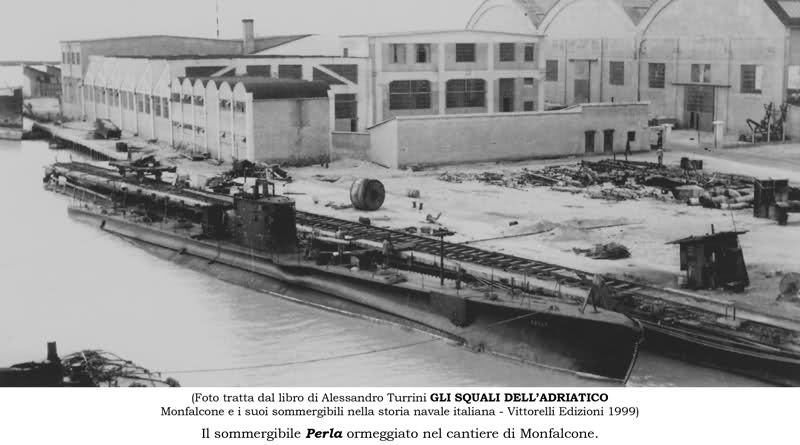
Specifications
Displacement: 680 t. standard -837 t. Diving
Dimensions: 60.18 m long, 6.45 m wide, 4.78 m draft
Propulsion: 2 propellers, 2 diesels Fiat / CRDA / Tosi, 2 electric motors CRDA / Marelli, 1400/800 hp.
Top speed: 14 knots surface / 7.7 knots dive
Armament: 1 of 100 mm AA, or 4 of 13.2 mm AA (2 × 2), 6 TLT 533 mm (4 bow, 2 stern, 16 torpedoes.)
Crew: 45
Adua class coastal submersibles (1936)

These repeats of the Perla were launched at CRDA Montfalcone (Adua, Alagi, Aradam, Axum), OTO Muggiano (Ascianghi, Beilul, Durbo, Gondar, Neghelli, Lafolé, Macalle, Scire, Tembien) and Tosi (Dagabur, Dessie, Uarschiek, Uebi Scelebi). They were the fourth group of the 600 tonnes superclass, and three more were built for Brazil. Four were modernized with new conning towers, an Gondar and Neghelli modified with canister to house Maiales or human torpedoes, for covert operations. Gondar was lost off Alexandria, attcked by destroyers, planes and later scuttled, and Scirè sunk by an armed trawler off Haifa. Nine other were sunk in action, mostly because of British destroyers. Two were rammed fatally, like the Tambien, by the cruiser HMS Hermione. Two, Macallè and Axum were lost after running aground, and Belul was captured and shortly operated by the Germans.
Acciaio class coastal submersibles (1941)
A series of 600 tons, adapted to the Méditerrannée, was brought to you by the engineer Bernardis in 1938. The construction was completed in the time of supply of resources, between 1941 and 1942. Inspired by Adua / Perla before being distinguished by a smaller kiosk of the German type plus a more powerful diesel. 13 units were launched in service by 1942, bearing metal names. “Acciao” means “steel”. They were built at OTO Lvorno, CRDA and Tosi. The class includes Acciao, Alabastro, Argento, Asteria, Avorio, Bronzo, Cobalto, Giada, Granito, Nichelio, Platino, Porfido, Volframio.
They were based in the Mediterranean, most were sunk by Allied ships during Operation Torch (landing in North Africa) and thereafter. Three were captured at the armistice and a fourth sabotaged. The Bronzo sank a British cargo ship at the Battle of Greater Sirte, the Giada remained in service until 1966, the Nichelio was given to the USSR in war damage (fate unknown) and the Giada, briefly British, was transmitted to FNFL for training.

Specifications
Displacement: 697 t. standard -850 t. Diving
Dimensions: 60.18 m long, 6.44 m wide, 4.78 m draft
Propulsion: 2 propellers, 2 diesels Fiat, 2 electric motors CRDA, 1400/800 hp.
Top speed: 14 knots surface / 7.7 knots dive
Armament: 1/2 of 20 mm AA, or 2/4 of 13.2 mm AA, 6 TLT 533 mm (4 bow, 2 stern.)
Crew: 45
Flutto class coastal submersibles (1942)
The Flutto class was the last class of Italian submersibles of the war. Planned for mass production, they were modeled on the Acciao designed by Bernadis, they were a little larger and equipped with more powerful diesels, giving them a better speed. There were 12 constructions but only 7 commissioned. Of these, there were three casualties in the battle, and the others were scuttled. Captured in November 1943 by the Germans and renamed UIT1-7, they were repaired and sunk in 1944.
The Nautilo was later bailed out by the Yugoslavs who repaired it and incorporated it into their navy after the war. The Marea was transferred to the USSR in war damage, and the Vortice, survived the conflict and was used in various roles until 1951, then reintegrated as a training ship from 1952 to 1967. From the 13th construction , the Bario, the series was a little bigger (64.20 meters long and 4.93 of draft), but none of the 14 scheduled was completed. Only three were launched in 1944, including those seized by the Germans and renamed UIT7 to 14, but none completed before the end of hostilities and scuttled in the CRDA yard in Montfalcone.

Specifications
Displacement: 930 t. standard -1,093 t. Diving
Dimensions: 63.15 m long, 6.98 m wide, 4.87 m draft
Propulsion: 2 propellers, 2 diesels Fiat, 2 electric motors CRDA, 2400/800 hp.
Top speed: 16 knots surface / 8 knots diving
Armament: 1 gun 100, 2 of 20 mm AA, 6 TLT 533 mm (4 bow, 2 stern, 12 torpedoes)
Crew: 50
Romolo class transport submersibles (1943)
These last Italian ships of the war, of a particular type since they were specialized submersible cargo ships to rally Japan by loading vital products for its war industry, gauged more than 2500 tons with full load, which in were the biggest ever built in Italy. Their armament was symbolic, since only their cargo mattered.
They were inspired by certain German units, including the Deutschland of 1915, famous for having crossed the Atlantic, rallied the USA, and returned to Germany with a cargo of products by forcing the blockade. The Romolo class, conceived in the light of the experience of the war, was started too late for these units to be operational: The first two, Romolo and Remo, launched in March 1943, were not in service very long before the capitulation Italian.
They were lost every two to three days in July (Romolo torpedoed by SM HMS United, and Remo by a US Navy aircraft). The other 10, R3 to 12, were still in dry dock or under construction for completion, and launched between October 1943 and September 1944 by the Germans who recovered and renamed them UIT1-6. They were never completed and destroyed by Allied raids.

Specifications
Displacement: 2,155 t. standard -2,560 t. Diving
Dimensions: 56.50 m long, 7.86 m wide, 5.34 m draft
Propulsion: 2 propellers, 2 Tosi diesels, 2 Marelli electric motors, 2600/900 hp.
Top speed: 14 knots surface / 6.5 knots dive
Armament: 3 guns 20 mm AA, 2 TLT 450 mm bow
Crew: 63
Italian Midget submersibles (1941-43)
CA class Midget submersibles (1941)
These units, designs proposed in 1937 by Caproni to the Admiralty, were built as submersibles of local defense, then aroused then its interest at the beginning of the conflict for a project which was important to the comando supremo: they were modified in secret in 1941- 42 to attack the east coast of the United States, entering the harbor of New York or Baltimore.
They had to be transported on the Leonardo da Vinci and use TNT charges. As a result, their torpedo tubes were removed, they received instead 8 charges of 100 Kgs each, to deposit under the hull of the enemy ships in an attack of the style carried out at the same time by the 10th flotilla in Gibraltar except that the supervision was much inferior.
The speed thus went up to 7 knots in surface and 6 in diving thanks to a relief of nearly three tons. But the operation was never ordered, although the CA2 was sent to Bordeaux for this purpose. The latter will be recovered by the Germans after the Italian capitulation (the CA1 will be shelling at La Spezia), and they made it jump in front of the advance of the Allied troops in 1944.
The second series including the CA3 and CA4, a little bigger, carrying 20 magnetic charges of 2 Kgs. additional, intended to cause waterways directly on the hull of the attacked buildings, will be initiated in 1942 on the principle of modifications made on the first two. They were never fully operational either and were scuttled at La Spezia in 1943.

Specifications
Displacement: 13.3 t. standard -16 t. Diving
Dimensions: 10 m long, 1.96 m wide, 1.60 m draft
Propulsion: 1 propeller, 1diesel MAN, 1 word. elect., 30/25 hp.
Top speed: 6.25 knots surface / 5 knots dive
Armament: 2 TLT 450 mm
Crew: 2
CB class Midget submersibles (1942)
Designed by Caproni to serve as submarines for port protection and coastal defense, these units were larger than CAs. 22 pins were started, but the time required for their construction was extended to capitulation, and only 6 submersibles were completed in 1942 and 6 more in 1943. The last 10 fell into the hands of the Germans, who completed them before to transfer them to the “Republic” of Salo.
The latter knew various spells but were mostly sunk. CB1, 2,3,4 and 7 will be handled by the Romanian Navy to operate against the Soviet Navy in the Black Sea. One of them was sunk by a Russian plane, the others will be sabotaged before the advance of the troops.
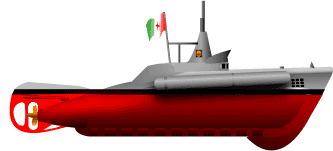
Specifications
Displacement: 35.5 t. standard -44.3 t. Diving
Dimensions: 15 m long, 3 m wide, 2 m draft
Propulsion: 1 propeller, 1 diesel Isotta-Fraschini, 1 word. elect. Brown-Boveri, 80/50 hp.
Top speed: 7,5 knots surface / 7 knots diving
Armament: 2 TLT 450 mm / 2 mines
Crew: 4
CM class Midget submersibles (1943)

These last units were designed to operate near the coast. Although much larger than the first, they retained a low autonomy. The first 3 were ordered at Montfalcone (CM) and the 3 others (CC) at Caproni, who had drawn the plans. However the first series was launched too late to enter service, the CM3 having even seen its construction canceled, as well as the following six.
Only the first one was launched in September 1943, and was immediately captured by the Germans who sent it north for completion, as well as the CM2. The buildings were renamed ITU17 and 18 for the Kriegsmarine, and only the first one will be completed to enter service in January 1945.
After the capitulation, he returned to the regia marina which used it under his former name in 1947-48 before the demolish. The CC series was significantly heavier, but overall unchanged, except for the addition of a DCA composed of two 13.2 mm machine guns. They were started in mid-1943 but none was launched or finished at the capitulation, the first state dismantled as the other two in situ and the other 32 planned canceled.
Specifications
Displacement: 90 t. standard -112 t. Diving
Dimensions: 33 m long, 2.90 m wide, 2.77 m draft
Propulsion: 2 propellers, 2 diesels Fiat, 2 mot. elect. CRDA, 600/120 hp.
Top speed: 14 knots surface / 6 knots dive
Armament: 3 TT 450 mm


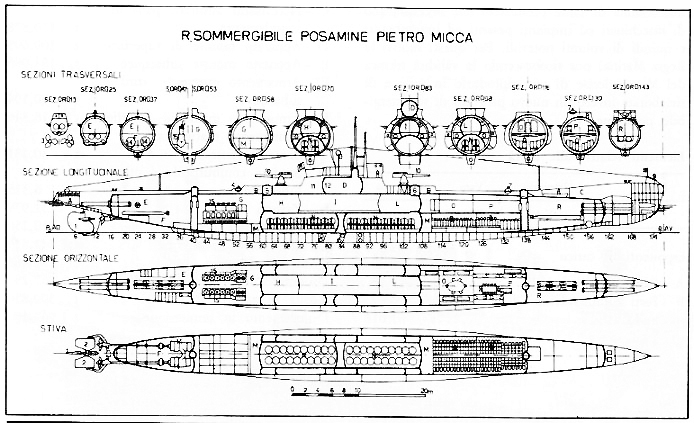

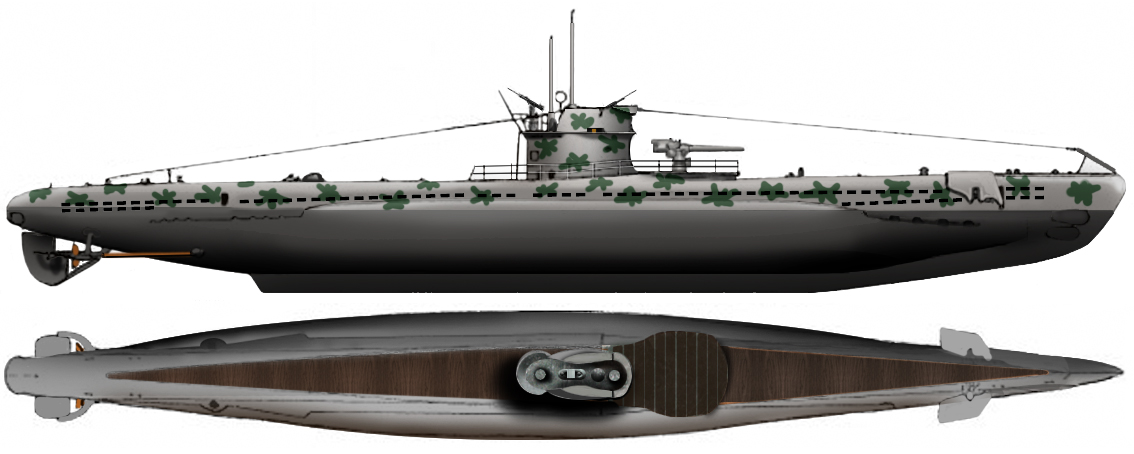
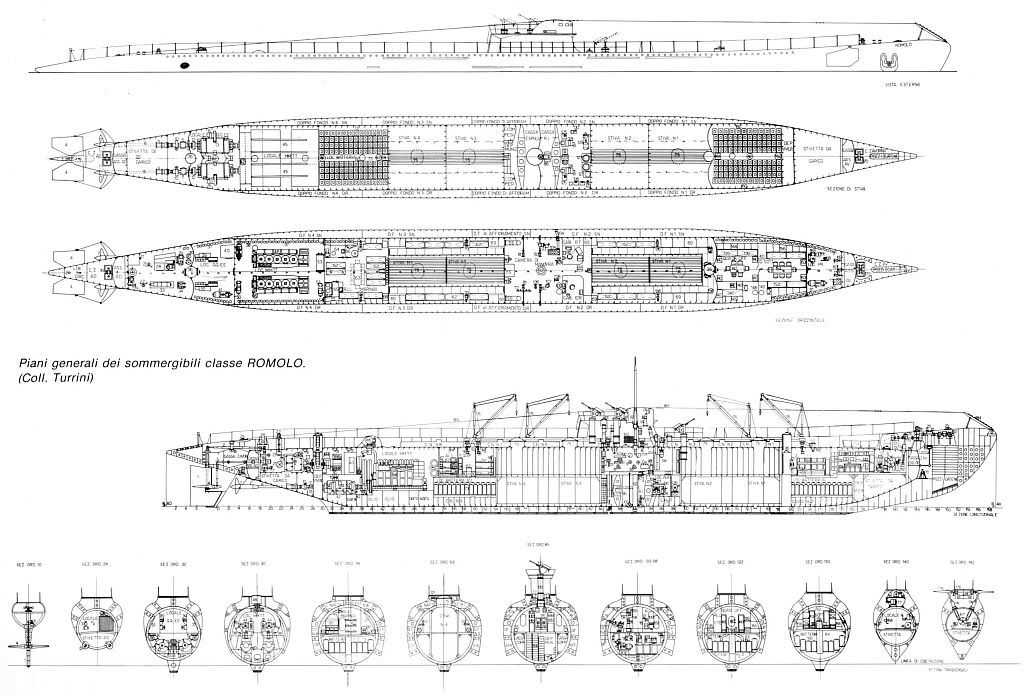
 Latest Facebook Entry -
Latest Facebook Entry -  X(Tweeter) Naval Encyclopedia's deck archive
X(Tweeter) Naval Encyclopedia's deck archive Instagram (@navalencyc)
Instagram (@navalencyc)





 French Navy
French Navy Royal Navy
Royal Navy Russian Navy
Russian Navy Armada Espanola
Armada Espanola Austrian Navy
Austrian Navy K.u.K. Kriegsmarine
K.u.K. Kriegsmarine Dansk Marine
Dansk Marine Nautiko Hellenon
Nautiko Hellenon Koninklije Marine 1870
Koninklije Marine 1870 Marinha do Brasil
Marinha do Brasil Osmanlı Donanması
Osmanlı Donanması Marina Do Peru
Marina Do Peru Marinha do Portugal
Marinha do Portugal Regia Marina 1870
Regia Marina 1870 Nihhon Kaigun 1870
Nihhon Kaigun 1870 Preußische Marine 1870
Preußische Marine 1870 Russkiy Flot 1870
Russkiy Flot 1870 Svenska marinen
Svenska marinen Søværnet
Søværnet Union Navy
Union Navy Confederate Navy
Confederate Navy Armada de Argentina
Armada de Argentina Imperial Chinese Navy
Imperial Chinese Navy Marinha do Portugal
Marinha do Portugal Mexico
Mexico Kaiserliche Marine
Kaiserliche Marine 1898 US Navy
1898 US Navy Sovietskiy Flot
Sovietskiy Flot Royal Canadian Navy
Royal Canadian Navy Royal Australian Navy
Royal Australian Navy RNZN Fleet
RNZN Fleet Chinese Navy 1937
Chinese Navy 1937 Kriegsmarine
Kriegsmarine Chilean Navy
Chilean Navy Danish Navy
Danish Navy Finnish Navy
Finnish Navy Hellenic Navy
Hellenic Navy Polish Navy
Polish Navy Romanian Navy
Romanian Navy Turkish Navy
Turkish Navy Royal Yugoslav Navy
Royal Yugoslav Navy Royal Thai Navy
Royal Thai Navy Minor Navies
Minor Navies Albania
Albania Austria
Austria Belgium
Belgium Columbia
Columbia Costa Rica
Costa Rica Cuba
Cuba Czechoslovakia
Czechoslovakia Dominican Republic
Dominican Republic Haiti
Haiti Hungary
Hungary Honduras
Honduras Estonia
Estonia Iceland
Iceland Eire
Eire Equador
Equador Iran
Iran Iraq
Iraq Latvia
Latvia Liberia
Liberia Lithuania
Lithuania Mandchukuo
Mandchukuo Morocco
Morocco Nicaragua
Nicaragua Persia
Persia San Salvador
San Salvador Sarawak
Sarawak Uruguay
Uruguay Venezuela
Venezuela Zanzibar
Zanzibar Warsaw Pact Navies
Warsaw Pact Navies Bulgaria
Bulgaria Hungary
Hungary

 Bundesmarine
Bundesmarine Dutch Navy
Dutch Navy Hellenic Navy
Hellenic Navy Marina Militare
Marina Militare Yugoslav Navy
Yugoslav Navy Chinese Navy
Chinese Navy Indian Navy
Indian Navy Indonesian Navy
Indonesian Navy JMSDF
JMSDF North Korean Navy
North Korean Navy Pakistani Navy
Pakistani Navy Philippines Navy
Philippines Navy ROKN
ROKN Rep. of Singapore Navy
Rep. of Singapore Navy Taiwanese Navy
Taiwanese Navy IDF Navy
IDF Navy Saudi Navy
Saudi Navy Royal New Zealand Navy
Royal New Zealand Navy Egyptian Navy
Egyptian Navy South African Navy
South African Navy






























 Ukrainian Navy
Ukrainian Navy dbodesign
dbodesign
Regarding WW I, the Sub Fleet had limited success, as Di Rivel’s main focus was on maintaining the successful blockade of the Imperial Fleet at Otranto Barrage. Further, sub warfare was in its nascent stages. Instead, he used his stealthy MAS torpedo boat squadrons under the great Rizzo. After he and his crew sank the Szent István on 10 Jun 1918, all hope of breaking the blockade had vanished. Regia Marina had, for all intents and purposes, won the war at sea in the Mediterranean.
Hello Brian, Thanks for your good point. It is more appropriate for the WW1 Italian submarine section, but the latter is still a draft. Hope we will resume this discussion there. Check FB updates for when it will posted !
Best,
David B, NE Manager